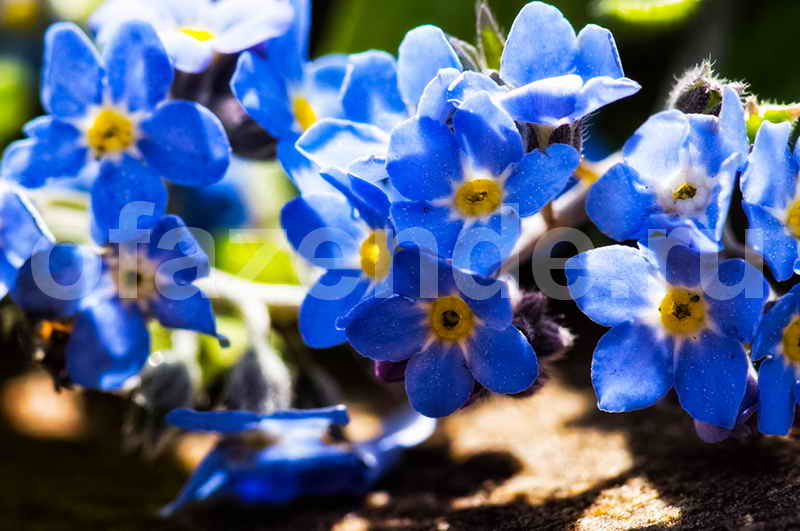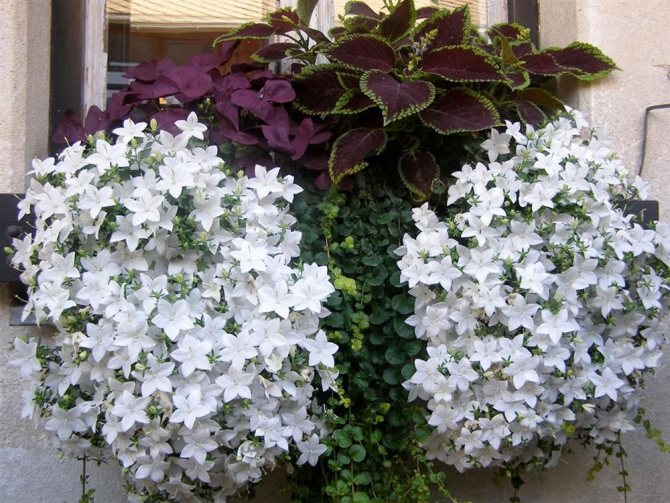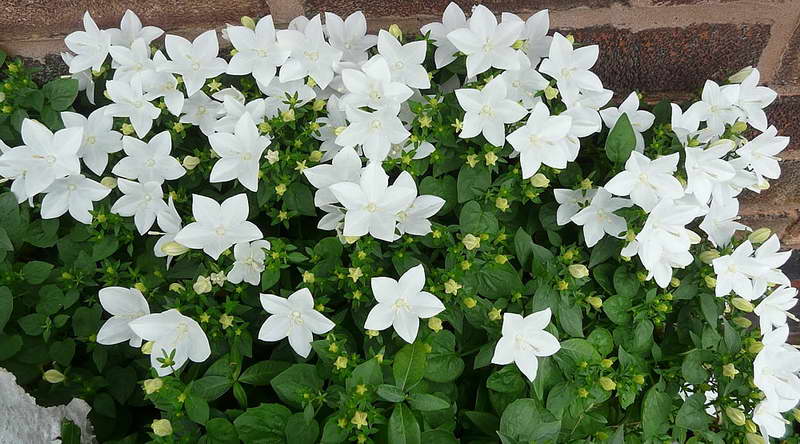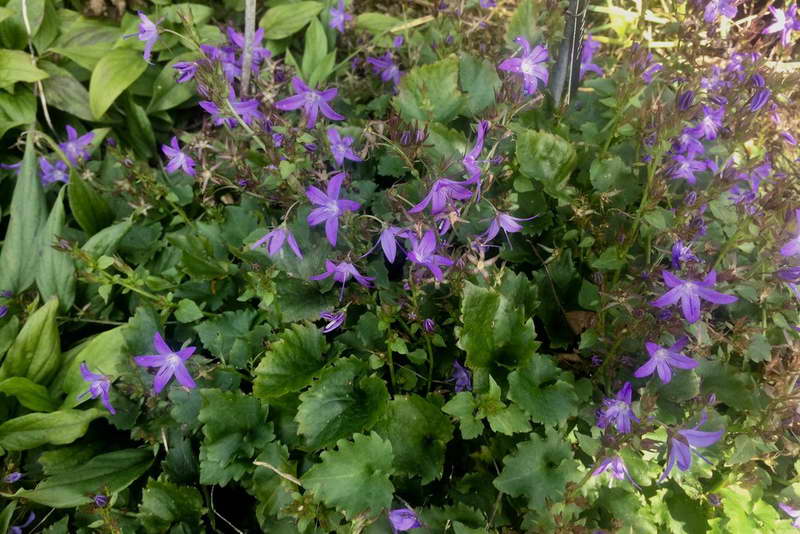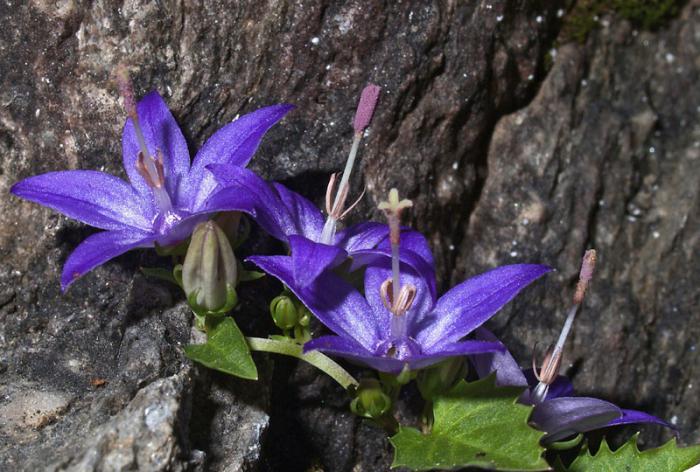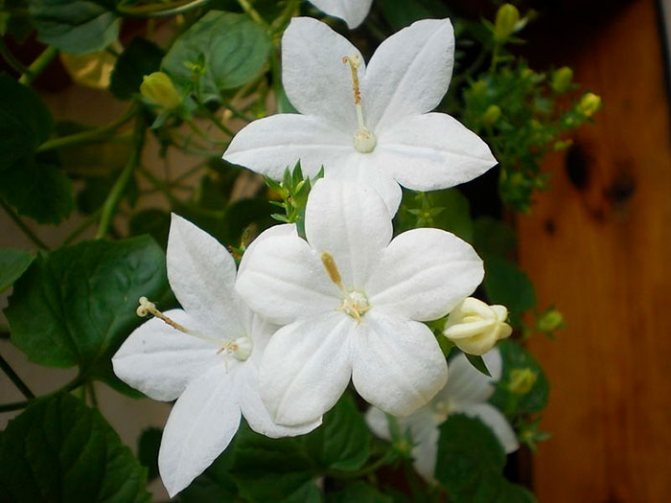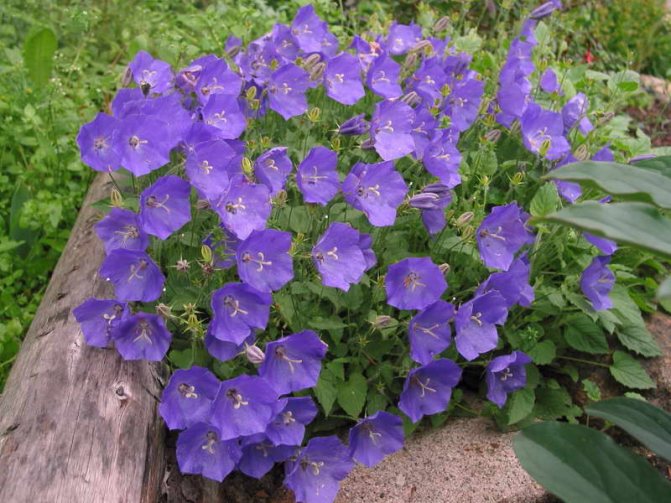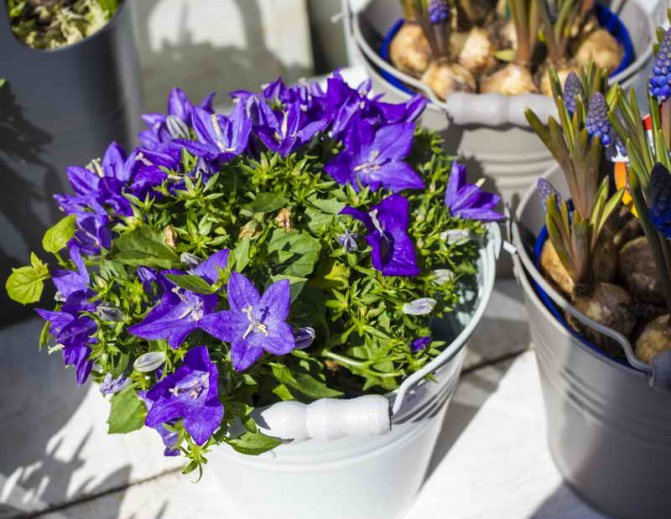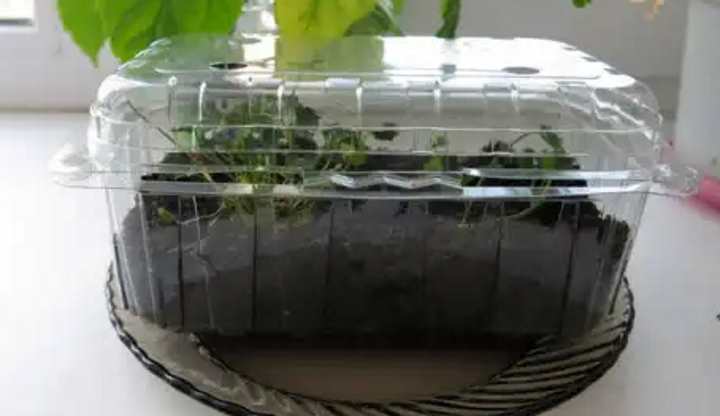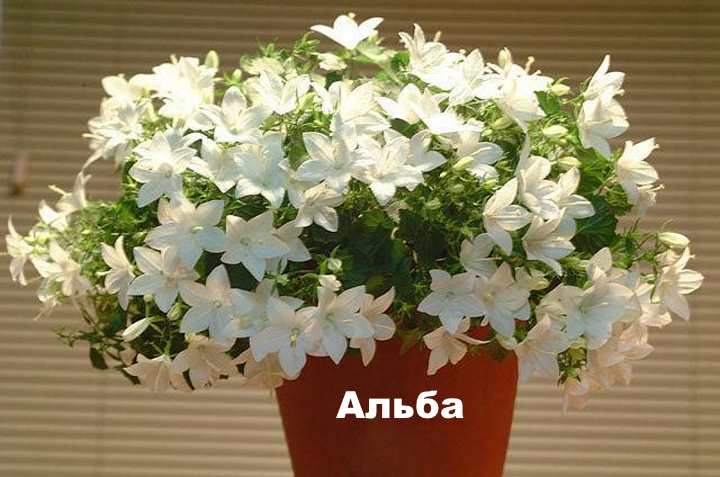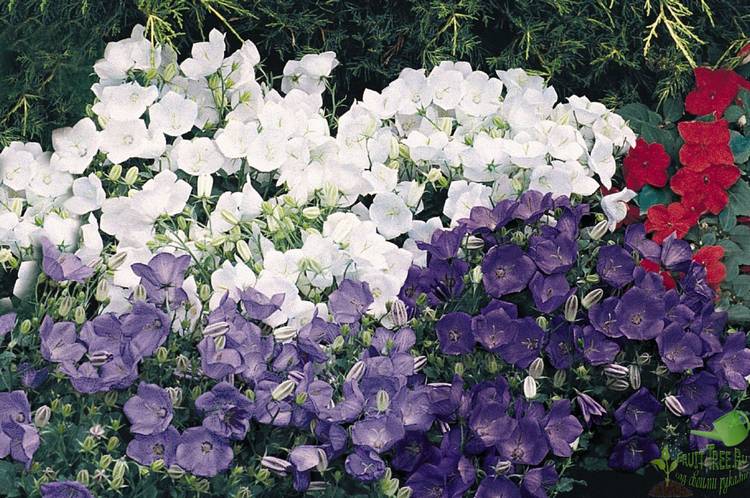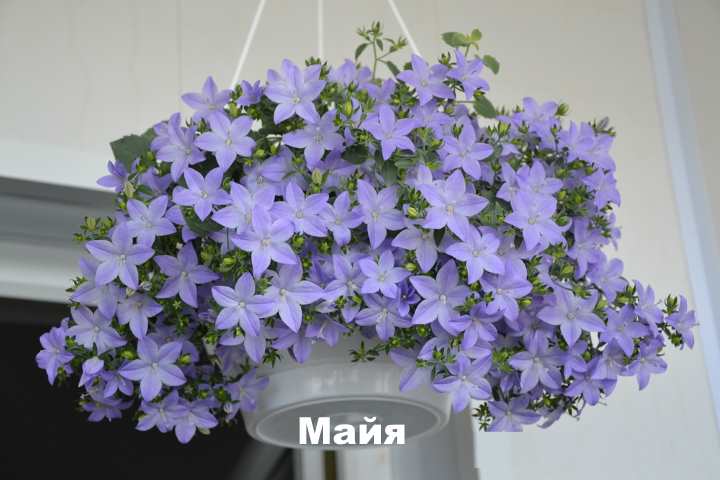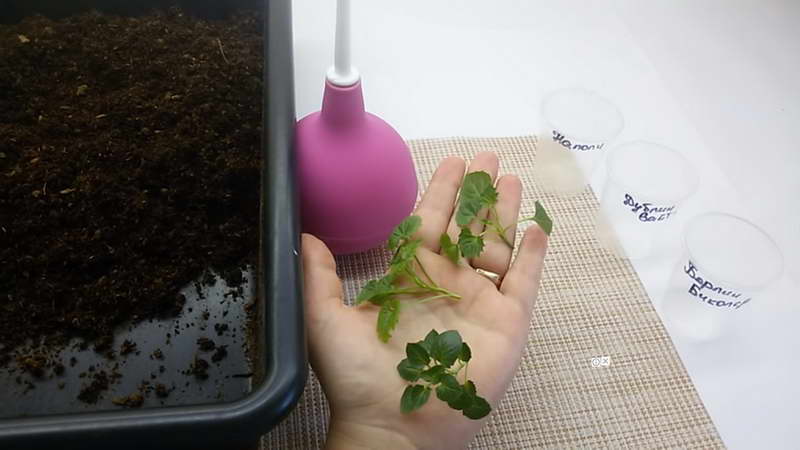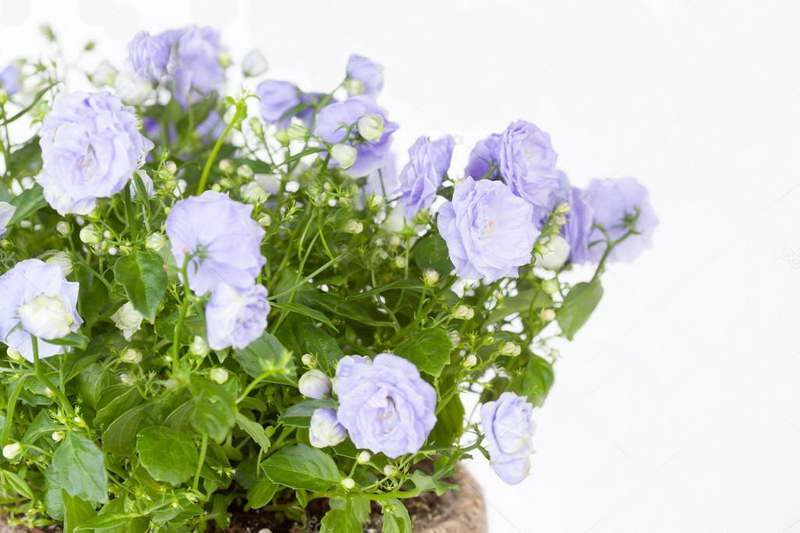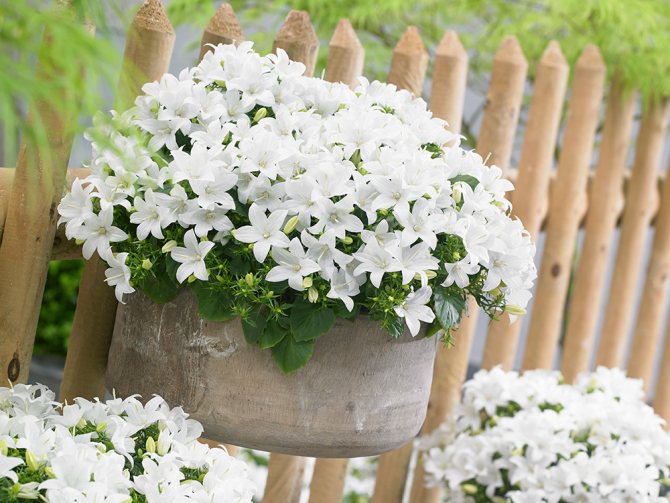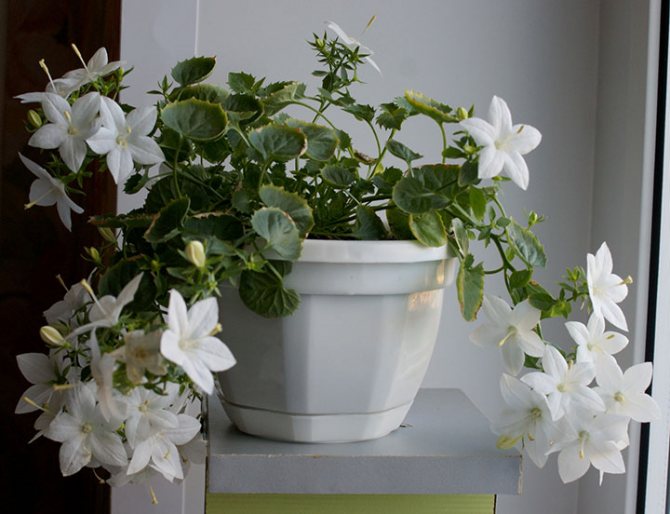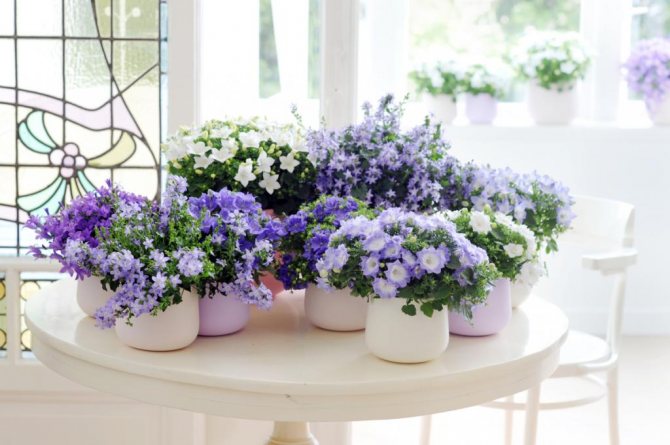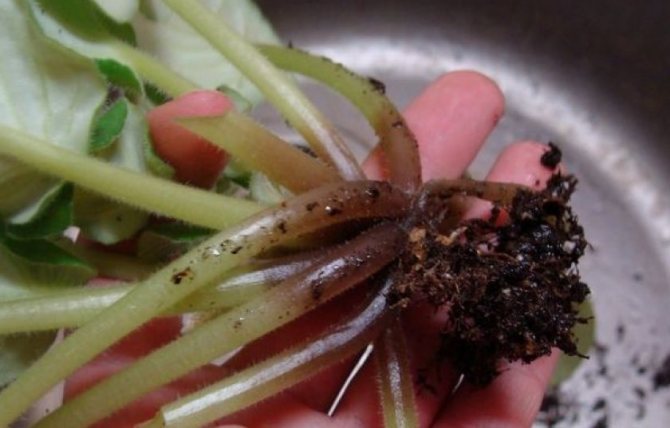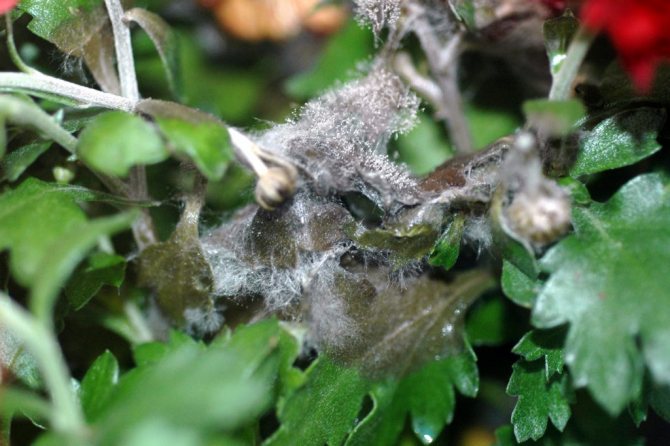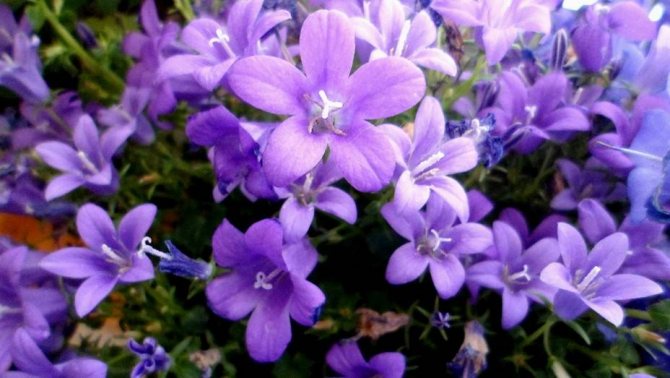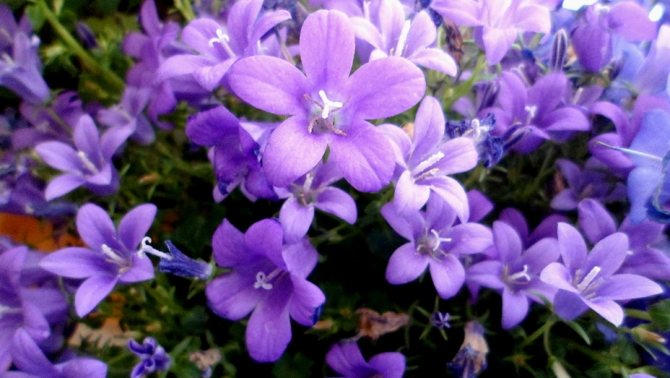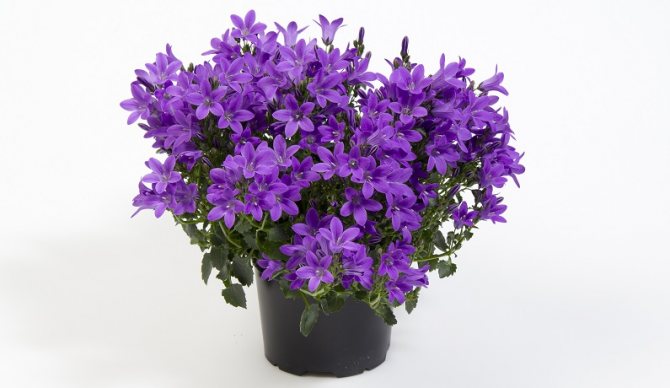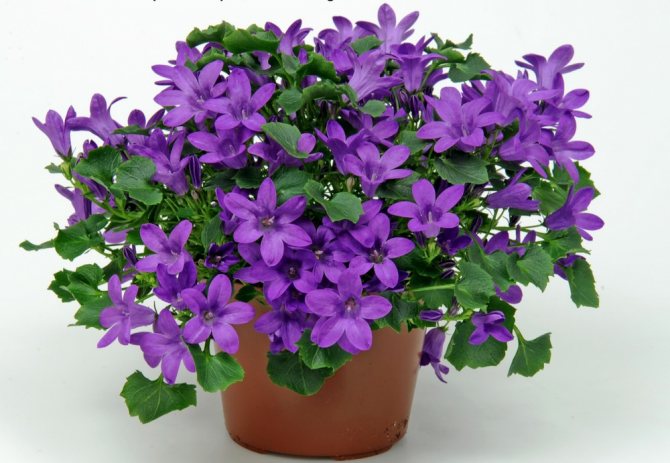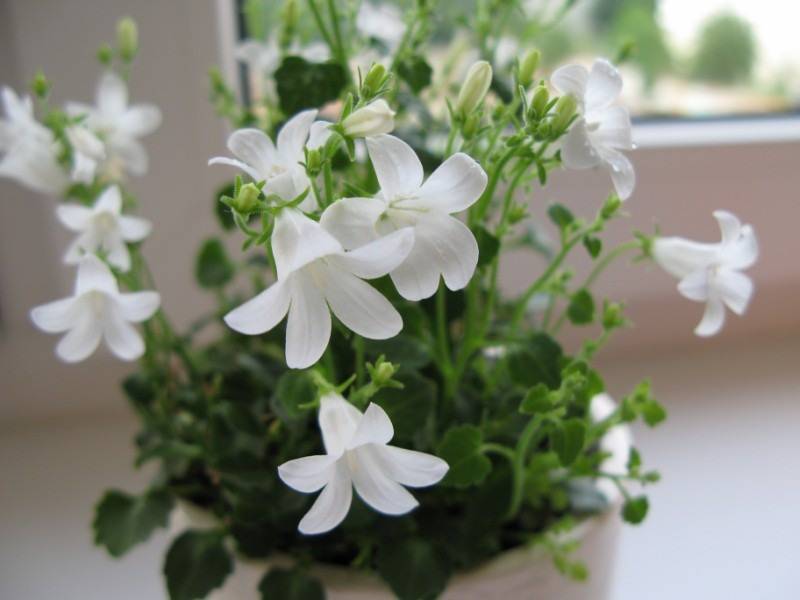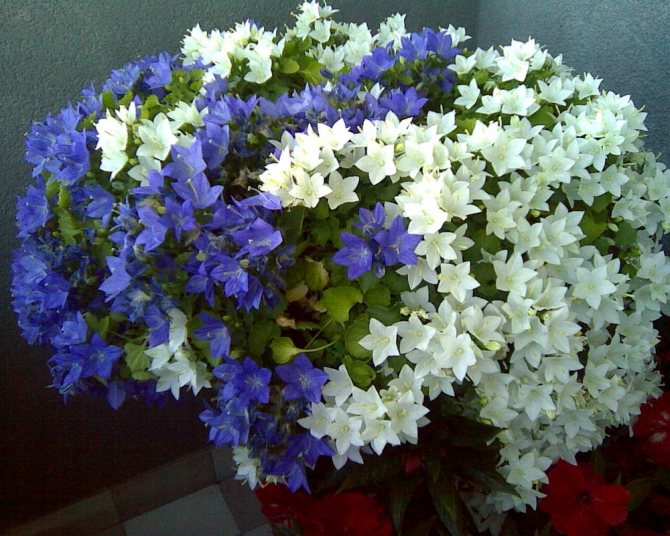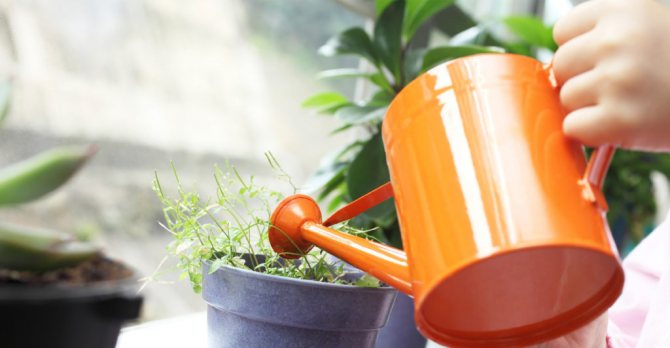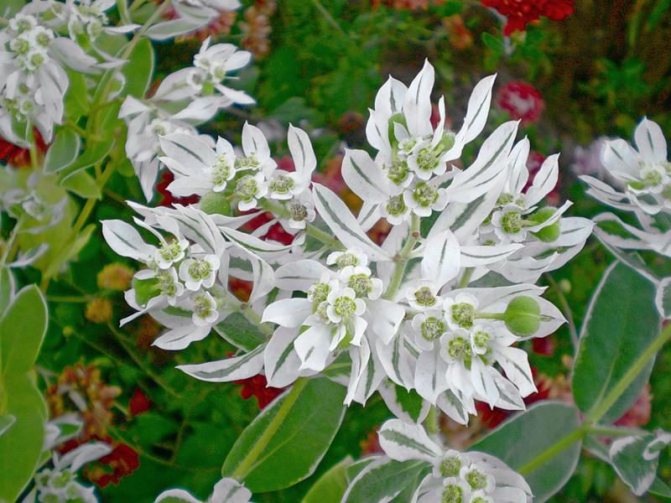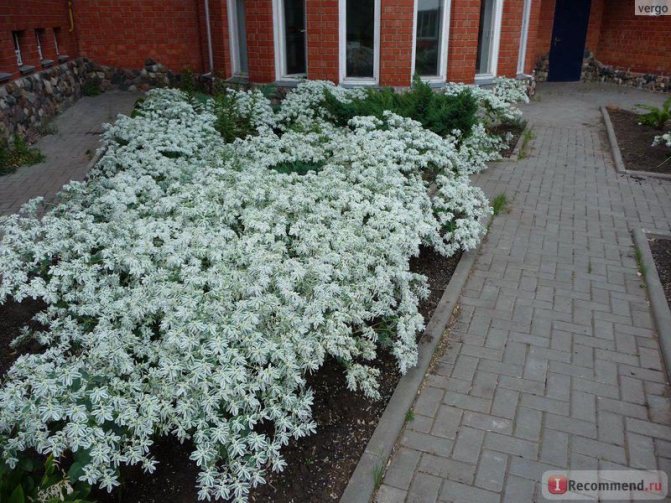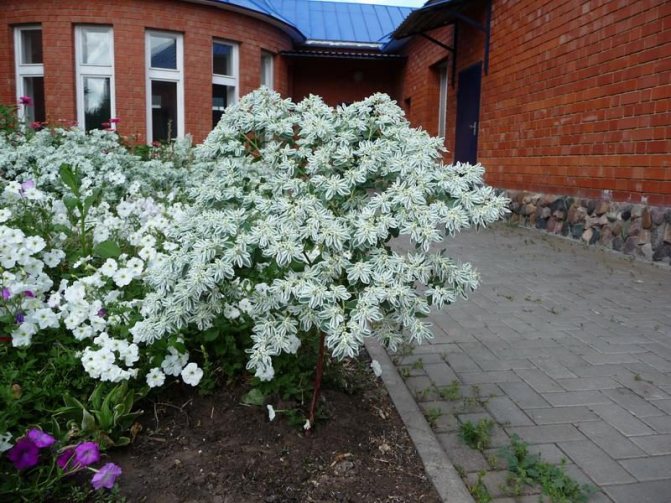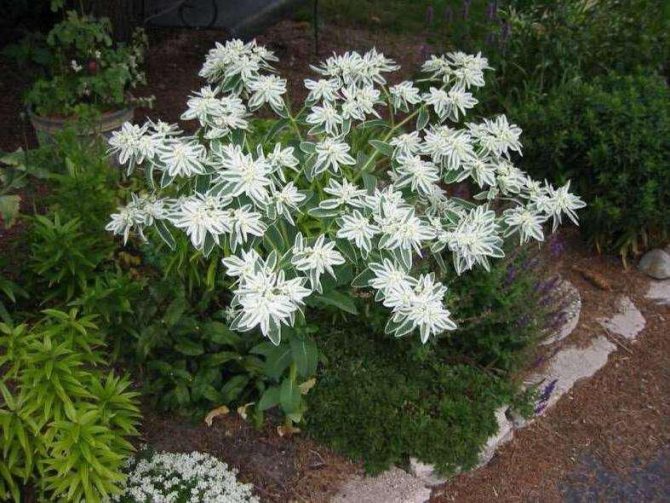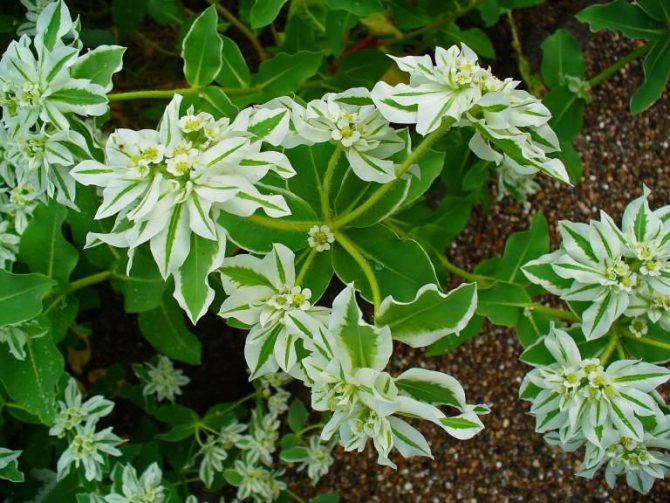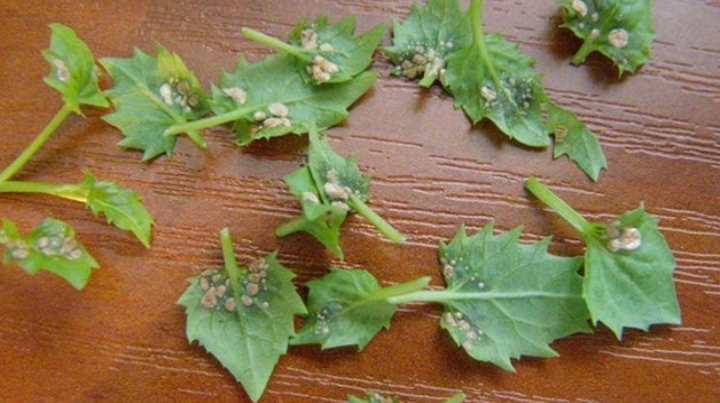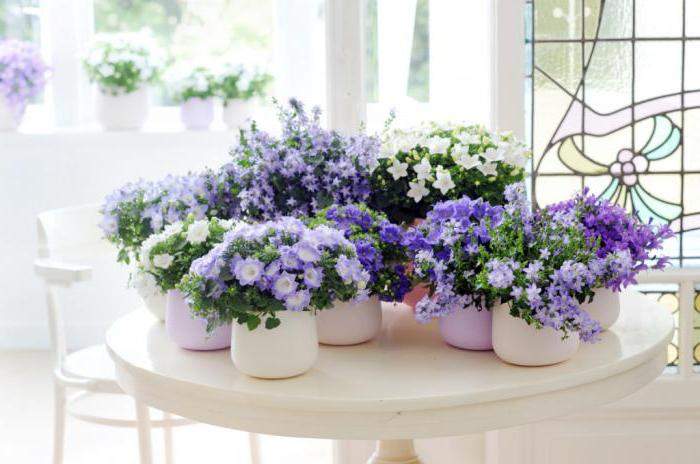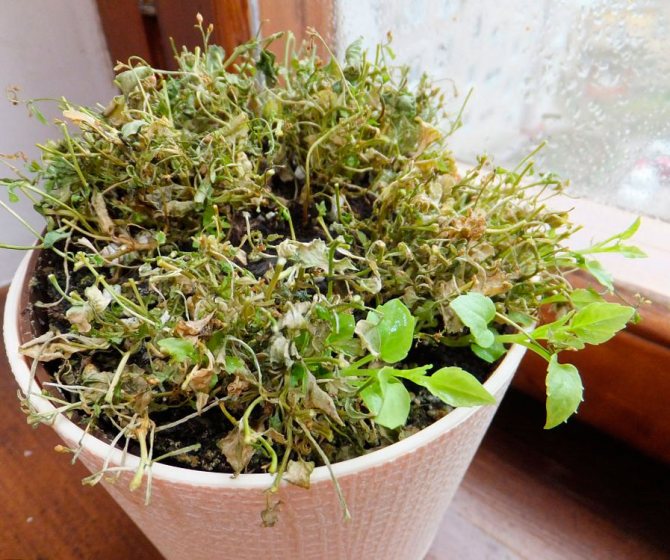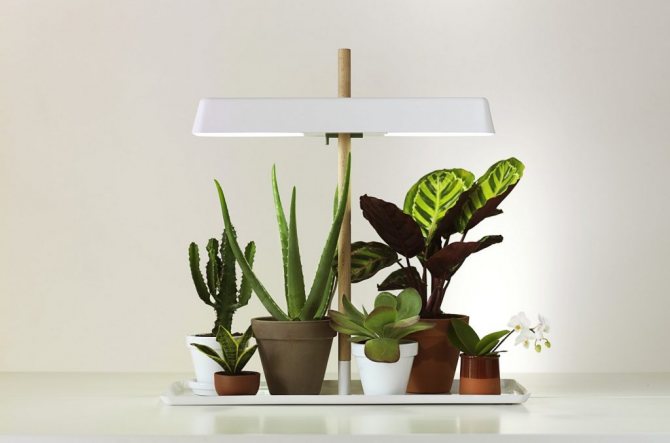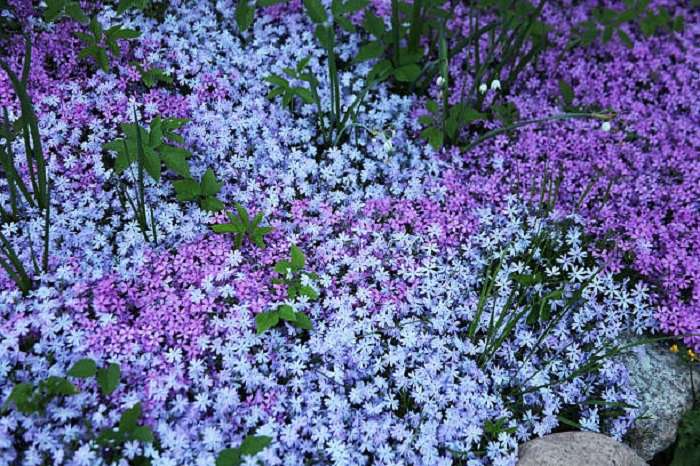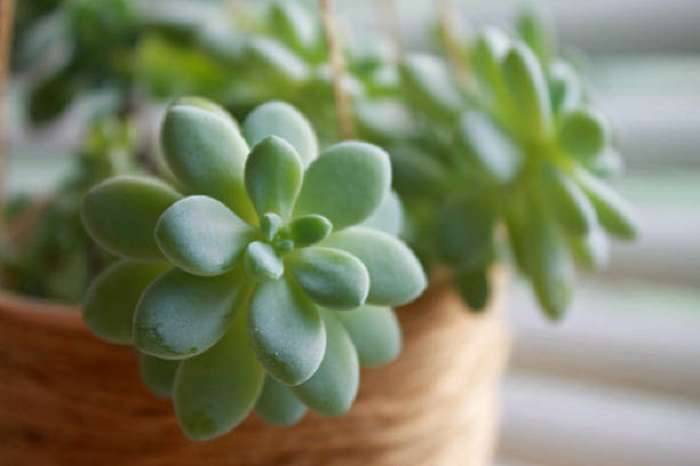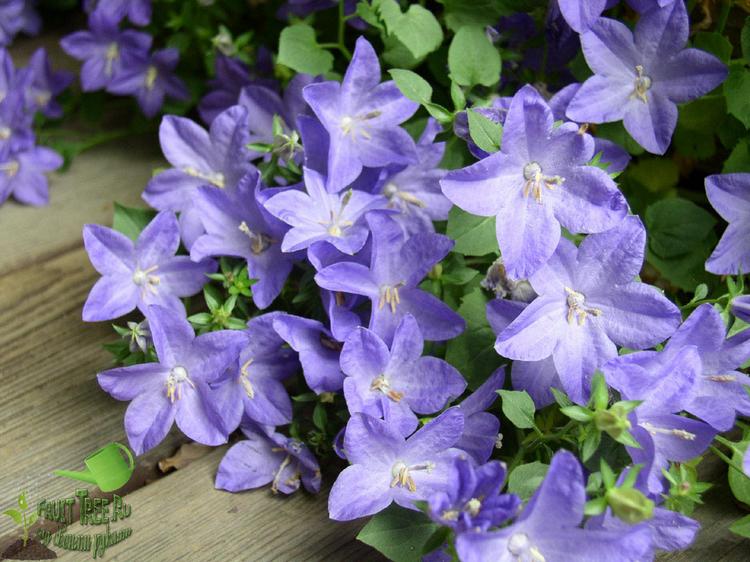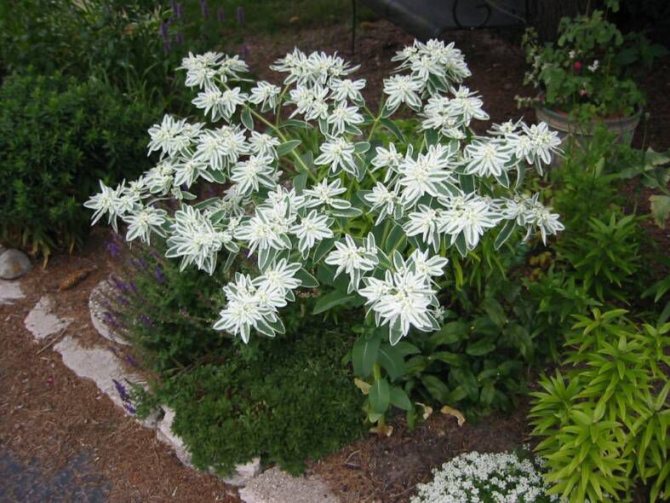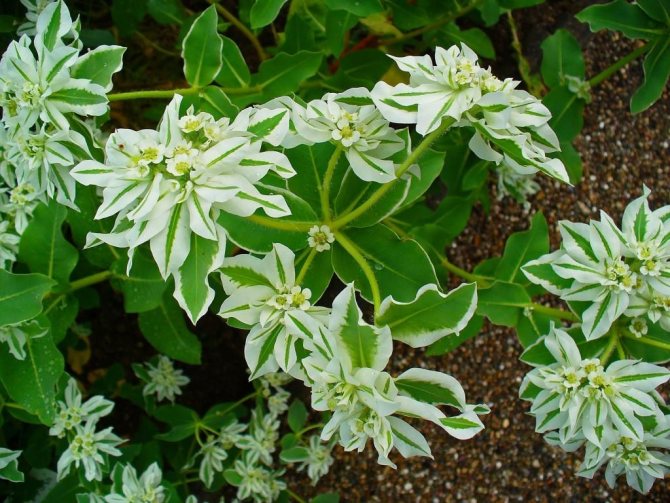The “bride and groom” flower (in Latin - Campanula) is a very delicate and unusually romantic plant. It is believed that it brings home comfort and family happiness to the house. And this is not surprising at all. An unpretentious bell can decorate any interior. These wonderful flowers used to be very popular. They were presented for happiness to newlyweds. It was believed that a family where such bells bloom and grow well will be very strong and happy.
Bride and groom. Care basics
Most often in the rooms you can find the campanula "Alba", blooming in white and "Maya", endowed with blue flowers. They are both hybrids and they are called Bridegroom and Bride.
The Bride looks like this:
- Long drooping stems (up to 30 cm).
- Leaves are oval. Attached to the trunk with long petioles.
- On each pedicel, towering above the bush, several buds are formed.
- The flowers have 5 petals, slightly bent back.
Advice. Compositions of two plants with flowers of different colors, planted in one container, look very beautiful.
Despite the very delicate appearance, the Bride indoor bell is not too whimsical.
- The first thing the Bride needs after the purchase is transplantation into fresh soil after several adaptation days.
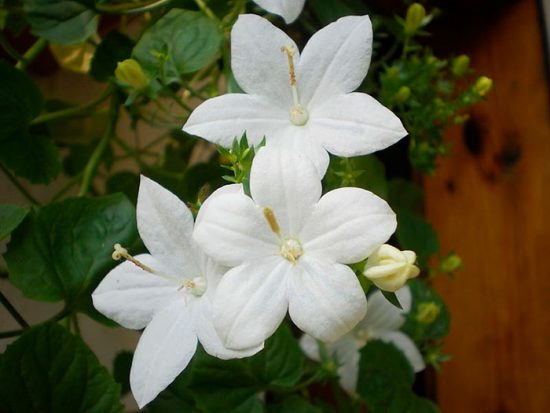
Alba
- A place for a flower should be chosen well-lit, but not exposed to sunlight. It is best to place the bell on the windows facing east.
Advice. To avoid sunburn, on hot days of summer, it is better to shade the plant with gauze or move it as far as possible from the window glass.
- The temperature indicators of a human dwelling, that is, about 20 ° C, are quite suitable for campanula. In the summer, you can take out the container with the Bride in the garden or on the balcony.
- Water the bride when the soil in the pot dries up. Use only rain or distilled water for this. An admixture of salts can negatively affect the condition of the plant.
- Reinforced top dressing is required for campanule in the spring, when it grows vigorously. Complexes of minerals for flowering are used as fertilizer.
Breeding features
Euphorbia, when grown in the garden, can propagate in two ways: by seeds and cuttings. Let's take a closer look at both options.
Cuttings
This method is rarely used when growing milkweed, since it is more difficult than seed. But if you nevertheless decided on grafting, get acquainted with the procedure algorithm.
- A stalk is cut that has at least one high-quality, developed kidney.
- The shoot is placed in a glass of water so that the milky juice comes out of the cut. As long as the milky juice covers the cut, roots cannot emerge.
- After the water procedure, the cutting is dried by placing it in a dark and cool room.
- When the shoot dries up, it is planted in a nutrient substrate in the open field. Before rooting, the cuttings are best protected from adverse weather conditions with a cut plastic bottle on top.
Seeds


Euphorbia itself is perfectly capable of propagating by seeds without assistance.In a short time, this plant can fill all the nearby free space: if you are satisfied with this state of affairs, you will not even have to help the bush in reproduction.
But if you want to approach seed reproduction with all responsibility, to form cultural plantings, use the following algorithm.
- For seedlings, seeds are sown in March, the soil should be moderately moist, nutritious and rather loose. Milkweed seeds do not need preliminary stratification.
- Before the emergence of seedlings, the container must be insulated on top with a film, after germination of the seeds, the shelter must be removed. The first shoots should be expected about a couple of weeks after planting.
- If the seeds were planted in a common container, pick the sprouts at the stage of formation of the third or fourth leaf.
- When the threat of recurrent frosts has passed, the seedlings are placed in open ground on a pre-prepared bed. Depending on the climate in the region, outside planting is possible from mid-April to late May.
Important: if you are planting several specimens, leave a distance of 30 cm or more between them. Do not forget that the bush in adulthood becomes very spreading, voluminous.
You can plant seeds before winter, directly in open ground. Thus, during the winter, natural stratification of seeds will occur, and in the spring the strongest and hardened of them will germinate safely.
We got acquainted with a unique plant known to scientists as euphorbia or euphorbia, and popularly as a "rich bride". There is nothing difficult in growing an unpretentious shrub: the main thing is to protect it from excess moisture and not be zealous with nitrogenous fertilizing. Euphorbia will thank you with lush flowering and will delight you with beauty throughout the summer.
Campanula: breeding methods
Indoor flower "Bride and Groom" at home multiplies in several ways:
- By dividing the bush.
- Cuttings.
- Young shoots.
Reproduction by dividing the bush
When transplanting an overgrown plant, it can be divided into several divisions. To do this, the bush is carefully taken out of the pot together with an earthen lump and is divided into parts with a knife. The cut sites are processed with crushed charcoal, and the cuttings are planted in new planting containers. It is not recommended to deeply bury them in the earthen mixture. Planted new bushes are watered with water at room temperature, and for the first time they are placed in a shaded place.
Cuttings
Cuttings can be obtained after pruning. For rooting, only segments from the bottom of the shoots are used. Rooting takes place in containers filled with a peat-sand mixture.
Caring for cuttings consists in spraying earthen sweep around them, and maintaining the temperature in the room within + 20- + 25C. When the segments take root and grow up to 10 cm in height, pinching is necessary. This will provoke the growth of side shoots.
If the cuttings were planted in spring or summer, then by autumn they will grow a little, and in autumn and winter they will rest. In spring, Campanula propagated from cuttings can bloom with proper care.
Musk mallow
It can also be called mallow. This is one of the elegant perennial garden plantings. It begins to bloom the next year after planting.
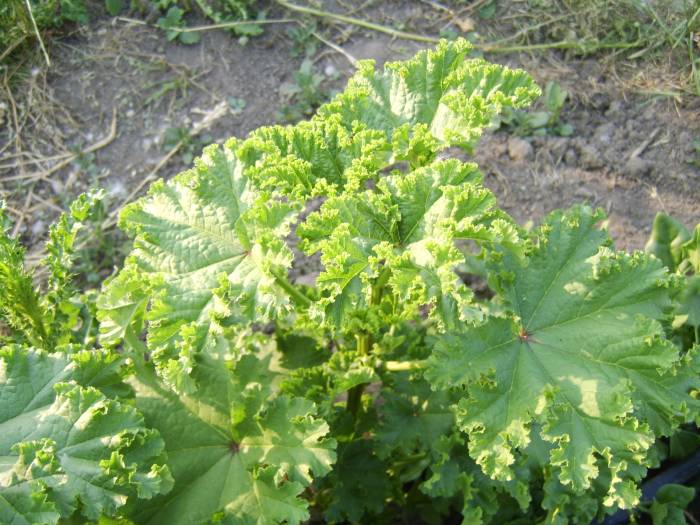

Mallow
Characteristics and growing conditions
Perennial lupine
The bride is called the musk mallow of the Alba variety. This plant is about 1 m high. It has not only beautiful, but also fragrant flower buds. Outwardly, they are a bit like the flowers of a Chinese rose, they reach 5 cm in diameter.
The site for planting mallow is chosen well-lit, protected from drafts. In the shade, this planting will not bloom so effectively. The soil should be nutrient-rich, loose.
Attention! The landing site must be chosen immediately. Due to its branched root, mallow does not tolerate transplanting well.
Care
The garden flower bride for many years is unpretentious in care, does not impose special requirements on the content. The activities that need to be done for good growth of the bush are as follows:
- moderate watering as needed;
- spring application of organic matter will contribute to the abundant formation of green mass and buds;
- after watering, the soil is loosened;
- overgrown shoots are tied to a support;
- after the buds have bloomed, they are removed so that the mallow does not waste energy on the formation of seeds;
- in autumn, after the end of the growing season, the ground part is cut off.
- for the winter, the root area is mulched, covered with spruce branches, sawdust, foliage.
The bride is rarely exposed to diseases of the garden flower perennial, but with an excess of moisture, there is a danger of being affected by various fungi. To eliminate them, the plantation is sprayed with a fungicide. Aphids or spider mites can also cause harm. To get rid of them, the mallow is treated with an insecticide.


Unforgettable about moderate watering
Reproduction
The most popular breeding method is by sowing seeds, in spring, in loose, nutritious soil. Small furrows are made, watered, seeds wake up in them. From above, they are covered with a thin layer of soil. After 3 weeks, the first shoots will appear. Musk mallow will begin to bloom in a year.
If the grower got one bush of this plant, you can try to dilute it with cuttings. Here's how to do it:
- the handle is cut off with a sharp tool;
- dipped in crushed coal;
- left for some time to dry;
- planted in a small pot, at the bottom of which drainage is laid and watered;
- from above the plant is covered with plastic wrap.
Important! The cutting tool must be well disinfected.
You can plant a perennial bride flower in the garden alone or in combination with other green spaces. He will give the garden solemnity, elegance. With proper care, it will grow in one place for a long time, and delight others with spectacular flowering.
Rest period and transplant
Indoor campanula is one of those plants that need rest. Only when a period of rest is ensured, the Bride will be able to please with abundant flowering in the next season. For this, in late autumn, the following manipulations are performed:
- The shoots are cut so that 10 cm remains from the root.
- The pot with the Bride is placed in a cool and always light room.
- Watering is greatly reduced - it is enough to moisten the soil once a month.
- Fertilizers are not applied at this time.
How to care
We will find out what kind of care the garden milkweed needs.
Watering
Frequent moistening of the soil in this case is not welcome. Euphorbia does not tolerate stagnation of water in the soil, reacts to this fact by rotting roots. Water sparingly and preferably towards evening.
Top dressing
The plant responds well to mineral fertilizers, reacts well to organic matter. The only caveat is that excessive nitrogen should be avoided.
Usually, after feeding, the plant shows a rapid leap in development and growth. Experienced gardeners recommend using a fertilizer with natural ingredients called Lignohumate for euphorbia.
Garter
A perennial shrub grows strongly, often its shoots sag, fall to the ground under the weight of foliage and buds. To prevent this from happening, you should tie the shoots to the support.
Pruning
Cut off the shoots of milkweed before wintering. The procedure should be carried out in late autumn.
Diseases and pests
Due to the fact that poisonous milky juice flows in the "veins" of the plant, it is not affected by pests. Euphorbia is also resistant to diseases, but does not like waterlogging and does not tolerate nitrogen.
How to multiply yourself
Lovers propagate the Bride in several ways:
- cuttings;
- planting young shoots;
- dividing the bush.
For the first method, in the spring, several strong stems are cut from the bottom of which sections 10-15 cm long are prepared. The sections are immersed in a growth stimulator for several hours, and then rooted in the sand under a cover of transparent material. The fact that the plant has taken root is signaled by the appearance of new leaves. After that, you can transplant the young campanula into a separate pot of suitable size.
Advice. When the bell reaches a height of 10 cm, pinch off the top. This forces the Bride to branch heavily, resulting in a lush bush.
In the spring, when the Bride is growing vigorously, you can find shoots that have appeared a little further from the base of the bush. They are carefully dug up and transplanted into nutrient soil. At first, the planting is covered with film or glass, while arranging daily airing. After the formation of new leaves, the shelter is removed and they begin to care for the young plant, as for an adult specimen.
Advice. When planting the Bride and Groom in the same container, it is advisable to divide the soil between them with a partition made of suitable material, since the white campanula is a stronger plant and, over time, can completely displace the Bridegroom.
Dividing a bush is the easiest way to propagate an indoor bell. It is carried out simultaneously with the transfer according to the following points:
- They moisturize the soil well.
- Carefully dump the plant along with a lump of soil from the pot.
- With a sharp knife, they cut into fairly large divisions.
- The incision sites are sprinkled with ash, which will prevent decay.
- Delenki are planted in prepared containers.
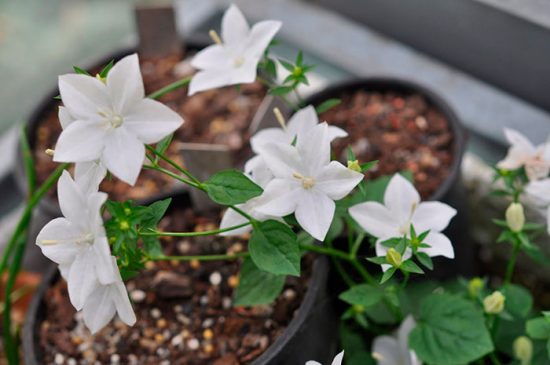

The plant is easy to propagate
Kalina Buldenezh
Garden hibiscus flower
Kalina varieties Buldenezh (Snow Globe) is a perennial shrub with white, large (7-15 cm) flower caps. She is also sometimes referred to as the bride.
Description and growing conditions
This is a tall (up to 3.5 m) shrub that begins to bloom in late spring - early summer. He has decorative not only buds, but also carved leaves. The crown reaches a diameter of 2-4 m. The more mature the viburnum, the more abundantly it blooms.
The landing site should be slightly shaded. It can be a wall of a house, a fence, as well as a tree growing next to a viburnum. The soil should be light, loose; sand is added to the heavy one. Dolomite flour or lime is added to the acidified soil.
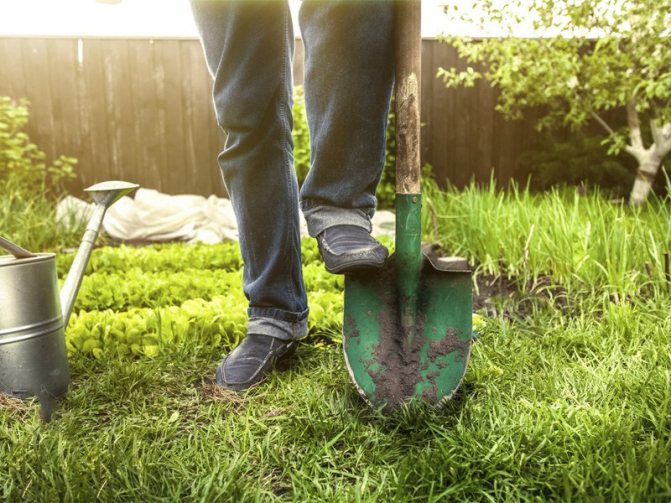

Landing in a darkened area
Landing
Viburnum Buldenezh is planted in open ground in spring or autumn. Let's look at this process step by step.
- A planting hole is dug with a diameter of 2 times the root system.
- Compost is poured onto the bottom of the pit, then the prepared substrate.
- A recess is made in the middle, into which the seedling is inserted.
- The roots are straightened.
- The rest of the earth is filled up, which is then rammed, watered.
The trunk circle is mulched to protect the root system from drying out, to preserve moisture in the soil.
Care
Kalina Buldenezh loves abundant watering, especially the amount of moisture should be monitored while the bush is young. In the year of planting, the bride is not fed: the fertilizer that was poured into the planting hole is enough for her. Organic fertilizers are introduced next spring, and complex fertilizers are applied in the fall.
Important! Before applying fertilizer, so as not to burn the roots, the soil must be shed with water. Watered again after application in order for nutrients to reach the root system more quickly.
After flowering, formative pruning is performed. All branches with buds are pruned so that young shoots grow, on which white balls form next year.
Like many green spaces, Buldenezh viburnum sometimes gets sick and is also exposed to pests.It is better to prevent these misfortunes by spraying the bush with permitted chemicals in the spring.
Reproduction
Starting in spring, Buldenezh viburnum is propagated by layering. To do this, the lower branches are bent to the ground, fixed with something, compost is poured on top.
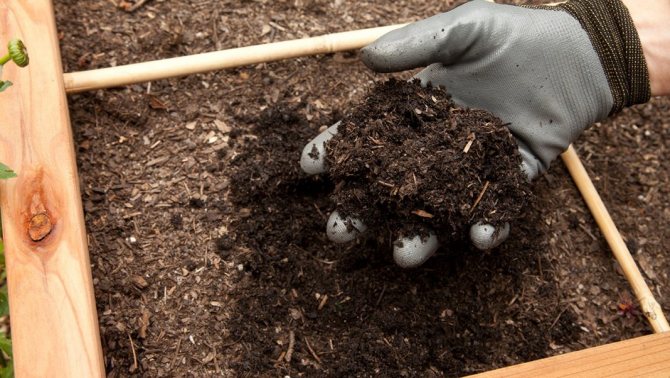

Compost
The rooting site is well watered. The offshoot is usually ready for independent life by next spring. Together with the root, it is separated from the mother plant and planted in a permanent place.
Another way to breed a bride is by cuttings. For these purposes, in June, shoots with 2 pairs of buds are cut and rooted in moist soil, covered with a transparent cap. The greenhouse is constantly ventilated, the cuttings are regularly watered. When roots are formed on them, they are transplanted for growing in a school, a year later they are planted in a permanent place.
Bride plant variety
Several types of plants grow well in home flower beds:
- The bellflower has small light green leaves and blue flowers. The plant does not exceed 20 centimeters in height. In recent years, flower growers have managed to achieve the appearance of white petals in this variety of Campanula, called Alba, and petals painted in mauve, called Maya.
- The brittle bell has fleshy leaves, blue flowers and long shoots that exceed 30 centimeters in length.
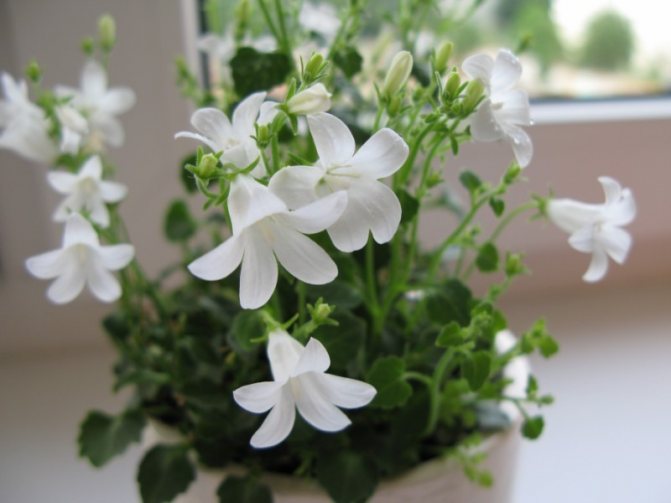

External characteristic
There are many varieties of milkweed, but only one of the species is called the bride - the bordered milkweed. This species boasts small, but multiple buds located at the very top of the shoots. The buds also have a white tint, however, the bush was not called the bride because of them. An unusual name is associated with foliage with a white border (see photo). Interestingly, at the beginning of their growth, the leaves are uniformly green, they acquire a white edge later.
The shrub is small in height, reaching only 80-90 cm. However, it grows very lush. The length of the leaves is 6-8 cm, the stems branch perfectly. The buds and foliage of the plant are not at all afraid of the sun, do not lose their decorative effect, do not fade even in severe drought. Milkweed bloom lasts from July to the first autumn frosts.
Application
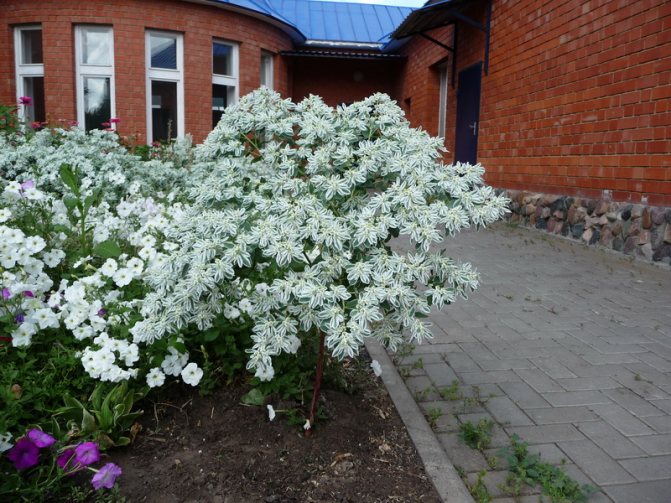

In landscape design, euphorbia is highly valued. With this light-colored plant, you can make remote corners of the garden more attractive and elegant. Due to the peculiar white color of the shrub, it is possible to achieve a visual expansion of the space.
In group plantings, euphorbia is usually used to separate those plants whose color does not combine well with each other. The spurge itself in this respect has a rare versatility, but its variegated foliage looks especially impressive against the background of red and blue flowers: roses, delphiniums.
Watering and humidity
In the spring-summer period, when the “bride and groom” flowers are actively growing and blooming, they need abundant watering and constant soil moisture. However, in this, too, you should know when to stop. Water should not stagnate in pots or trays. In the fall, the watering of the plants should be reduced a little so that the flowers can prepare for rest. In winter, when the "bride and groom" are kept cool, they need to be watered very rarely (once or twice a month). The plant is completely unpretentious to moisture. However, in the heat and when located near the battery in winter, it will not be superfluous to regularly sprinkle the leaves with water at room temperature.
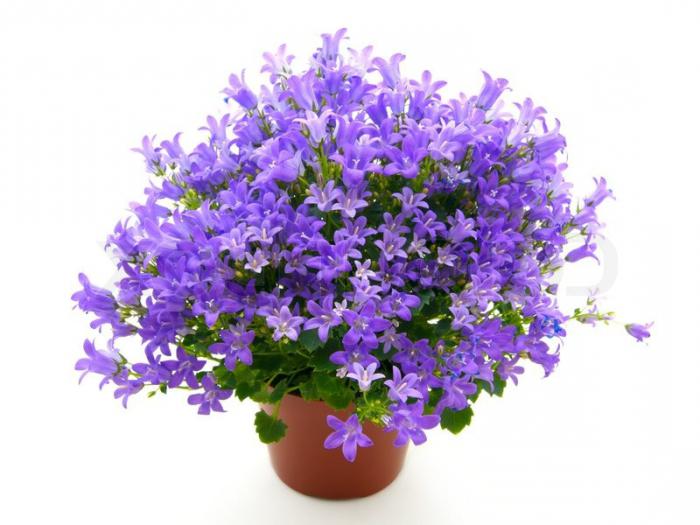

Plant diseases and pests
The most common problem of campanula is the fungal disease gray rot. As a rule, the cause of its occurrence is excessive watering and too high air humidity. When root decay begins, the plant becomes very sluggish and the soil takes on an unpleasant odor. What needs to be done? First of all, remove the affected part and transplant the flower. In addition, watering should be reduced.
Campanula pests that need to be controlled with insecticides are:
- spider mite;
- shield.
So, “the bride and groom” is a delicate and unpretentious flower from the bellflower family. It is enough to provide it with suitable conditions and care, and the plant will give a lush scattering of beautiful flowers and turn the house into a real fabulous garden.
Site selection and lighting
The bride and groom flower prefers bright but diffused light. The best place for it is the east or west window. If the plant is placed on the south side, you will need to create shading to get rid of direct sunlight. On the north window, the flower will most likely not have enough light, which can lead to stretching of the shoots and an increase in gaps between the leaves, which will worsen the appearance of the campanula. In summer, the flower feels great at an air temperature of 20-22 ° C, in winter - from 12 to 15 ° C.
Charming campanula
Campanula ("The Bride and Groom") is a perennial herbaceous bell native to the Mediterranean. There are approximately 300 species of these flowers in nature. Plant height - about 20 cm, creeping stems, creeping, heart-shaped leaves are located on long petioles. Their length is 5 cm. The surface of the leaves is light green, the edges are jagged. Campanula flowers are white or light blue, five-petalled, bell-shaped, resembling a star, up to 4 cm in diameter. They bloom at the tips of the shoots and form a lush ball of bells.
The garden flower "bride and groom" blooms during the whole warm season almost continuously and so abundantly that sometimes you can't even see the foliage behind the cap of the "stars". Flowering begins in spring and lasts until late autumn. Fruit type - box.
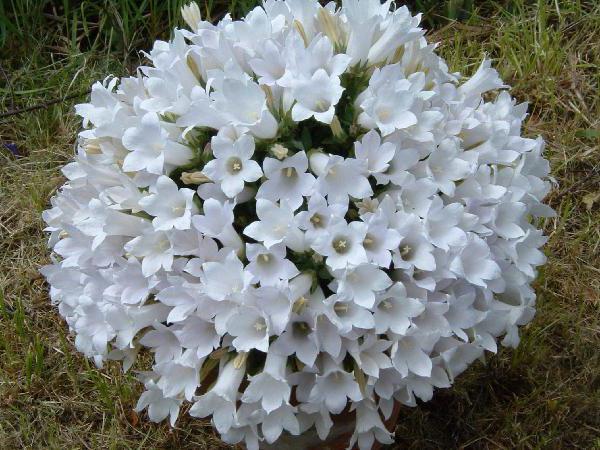

What to do if the Bride does not bloom
Sometimes it happens that the plant "refuses" to bloom. This situation can arise for several reasons:
- The bell grows in a larger pot than it needs. For many buds to form, you need a cramped pot.
- The plant lacks certain substances for flowering. During the period of increased growth, the Bride should be fed twice a month.
- Timely pruning is not carried out. Buds are not formed on lignified shoots, so Campanula needs to be rejuvenated annually.
- Sometimes the reason lies in the wrong placement of the shoots. By nature, they must hang down, so any attempt to raise them may be accompanied by a negative reaction from the plant.
The bride is an amazing flower that, with proper care, is capable of giving beauty and extraordinary tenderness. In return, it does not require special attention, so anyone can grow it.
Soil for planting
The delicate plant turned out to be very unpretentious. Indoor growing is not difficult.
A fragile flower that appears in the house is allowed to adapt for several days. After that, you can start transplanting the plant into another container. The pot for planting indoor flowers "bride" is selected quite wide. Campanula roots grow rapidly, filling the entire volume provided. To provide them with active breathing, a fresh, very loose soil mixture is prepared. To do this, take the components in the same proportions:
- peat;
- humus;
- river sand of a coarse fraction.
At the bottom of the container, expanded clay or pebbles are poured as drainage with a layer of about two to three centimeters. In this way, they keep the roots from getting wet if accidentally watering is excessive.
How to buy Campanula home flower seeds on Aliexpress?
You will have to flip through many pages to find campanula among the huge variety of seeds of various plants. This flower is rare on this portal. As, however, it is difficult to find it in flower shops. And yet you can.
To do this, follow the link and scroll through the pages, as a rule, they are found under the name - rare seeds in a single copy.
Home flowers on Aliexpress can be viewed at this link.
If you have not ordered goods before, then read the instructions in the article "First order for Aliexpress".
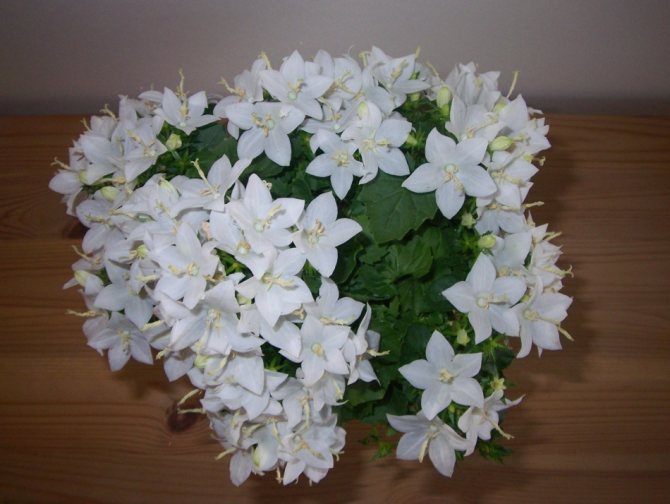

Campanula white - flower bride
Growing campanula from seeds When to plant
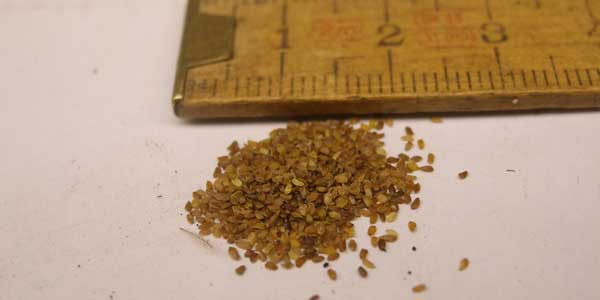

Campanula seeds photo
Growing a campanula from seeds is not difficult. Start sowing in early spring (late February - early March). You will need wide, flat containers with loose soil (use a multipurpose growing medium or a sand and peat mixture).
- The seeds are very small, for easier sowing, mix them with sand.
- Spread the mixture over the surface of the soil, as if you would add, and spray from a fine spray.
- Seed germination lasts about a year, but it is better to spray after sowing not with water, but with a solution of a growth stimulator (Epin, Kornevin, Zircon) to make sure that the seeds will sprout.
- Cover crops with plastic or cling film, place in a place with diffused lighting.
- Maintain temperature between 23-25 ° C, bottom heating is excellent.
- Raise the cover for a few minutes every day to remove condensation.
- Providing favorable conditions, seedlings will appear after 5-7 days, then the shelter can be removed.
- Leave the light level and temperature the same so that the seedlings do not stretch out.
- Care consists in spraying from a fine spray as needed, do not overmoisten the substrate.
- After the appearance of three or four real leaves, you can sit in separate containers.
Transplant and feeding
Campanula prefers loose soil that allows the roots to breathe freely. For planting it, you can purchase ready-made soil for flowering plants or make a mixture, the ingredients of which are:
• sheet land; • peat land; • humus; • coarse sand.
A campanula transplant is carried out every spring, in the second or third decade of March. However, the plant does not have a very long lifespan, so new cuttings can be planted every year. Campanula lives on average in a room for 1-2 years, then it should be updated. It is very important that at the bottom of the plant pot there is a drainage layer in a third of the container.
Bride and groom flowers are great for growing in pots and hanging containers. The strong root system of Campanula needs a wide, not deep pot.
In spring and summer, the plant can be fed with fertilizers for flowering plants every two weeks.
Description
The bride shrub grows best in warm climates. That is, on the territory of our country, southern regions are suitable for its cultivation, for the most part. Even in the middle lane, the plant is not very common due to its thermophilic character. But starting from about Tambov and to the south, gardeners with great pleasure cultivate euphorbia.
Euphorbia is famous for its rapid growth: a few months pass from the moment of planting to the appearance of a lush, bushy plant. The spurge looks gorgeous in the garden, representing a real decoration of the surrounding landscape.
Since the plant easily reproduces in favorable conditions by self-sowing, it is able to "occupy" all nearby free territories in a short time. If you are not too happy with this garden design option, you will have to remove the seed pods in time.
Plant Bride and Groom: home care, watering
To prevent the leaves of the flower from withering, this plant should not be placed in places where direct sunlight falls. But the dark sides of the apartment will not suit bells either; choose well-lit areas. The eastern side is most suitable for campanula. The ideal temperature for a plant is 22-24 ° C.
It is very beautiful if you place these miracle flowers in a flowerpot. The stems will quickly grow, you get a chic design element of the room.
The plant loves watering.You can moisten it once or twice a day - as needed. It is good that it is not necessary to spray it even during the heating season.
Campanula should also be fed with special flower fertilizers approximately - once every half a month.
Your houseplant will delight you with flowering all summer. After flowering, the shoots should be cut off. In winter, store the bell at a low temperature (14-16 ° C), and water it to a minimum.
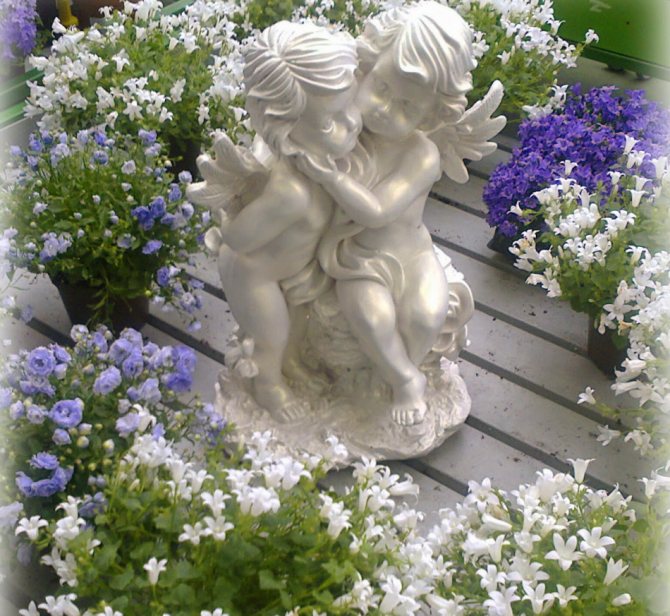

Campanula care
IMPORTANT: If you moisturize the flower too much, then a very dangerous disease can appear - gray rot. Thanks to her, the roots of the campanula will die. A spider mite appears when the flower is watered very rarely. To eliminate the parasites, treat the bell with insecticides.
Features of watering campanula
In summer, it is necessary to water the flower regularly and at the same time abundantly, in winter it is necessary to water the plant somewhat less, between waterings the soil should completely dry out.
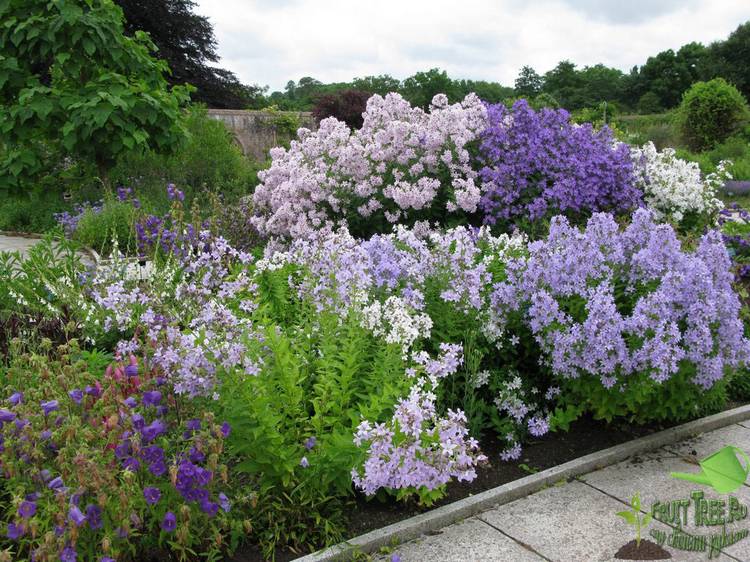

The humidity of the air for the normal development of this flower must be quite high, because this flower does not tolerate dry air. At the same time, it is necessary to constantly monitor the purity of the leaves of this plant in order to prevent the appearance of aphids or ticks.
If the indoor air is too dry, it is necessary to periodically spray the plant to humidify the air around the flower. At the same time, you do not need to allow excessive moisture, this is also harmful.
Indoor flower Bride and groom: folk signs and superstitions, the meaning of a flower
House bells are a symbol of a happy family life. It is popularly believed that campanula fills space with only positive energy, if properly cared for. Moreover, it is completely unpretentious. Most often, two types of plants, white and blue, are bought into the house so that there is a couple.
Bells are able to pick up negativity from the owner, hostess and other residents of the apartment, in stressful situations. They say that if a flower suddenly dried up, then it took away the damage, the evil eye from one of the inhabitants of the house. In this case, the plant should be thanked and buried in the ground outside.
In addition, these flowers improve the general mood and give a boost of energy to all the inhabitants of the apartment.


Superstitions, omens - the influence of the Campanula flower on people
Transplanting campanula after purchase and during the growing season
Note that Campanula retains its decorative effect for 2-3 years. More often it is not transplanted, but is renewed annually.
In stores, campanula is mainly grown in hydroponics; for home cultivation, the plant is planted in a container with a substrate. The soil is required to be loose and light, with good water and air permeability. A mixture of leaf and peat soil, prepared in equal proportions, is ideal. You can take a universal substrate for growing flowering crops, add a little peat, humus or rotted compost, coarse river sand to it.
If you decide to grow Campanula for several years, the best time to transplant is early spring or mid-autumn (before or after flowering). With each transplant, increase the depth and diameter of the container by 3-4 cm. If the pot is too bulky, the campanula will begin to “fatten”, ie. the root system and the ground part will actively develop to the detriment of flowering.
The transplant includes the following steps:
- Fill the selected container by ¼ volume with drainage (expanded clay, pebbles, clay shards, pieces of foam, any material can be used independently or mixed);
- Pour the substrate halfway;
- Carefully remove the plant from the previous container, trying to keep the earthen lump. To make it easier to do this, water the flower of happiness the day before transplanting.
- At the bottom there will be many roots that have fallen into a solid pile. Using a sharp, sanitized knife, cut a length of about 5 mm. Several longitudinal cuts with a depth of 3-5 mm should be made on the sides.
- Transfer the campanula to a new container and add the missing amount of substrate.Press down lightly on the soil near the surface.
- Water the Campanula moderately. To adapt, keep in a cool (18-20 ° C) shaded place. When it grows, you can return to its previous conditions.
Lobelia
Another flower that I adore grows in my country house. This is lobelia. Lobelia is a genus of annual and perennial herbaceous plants of the family
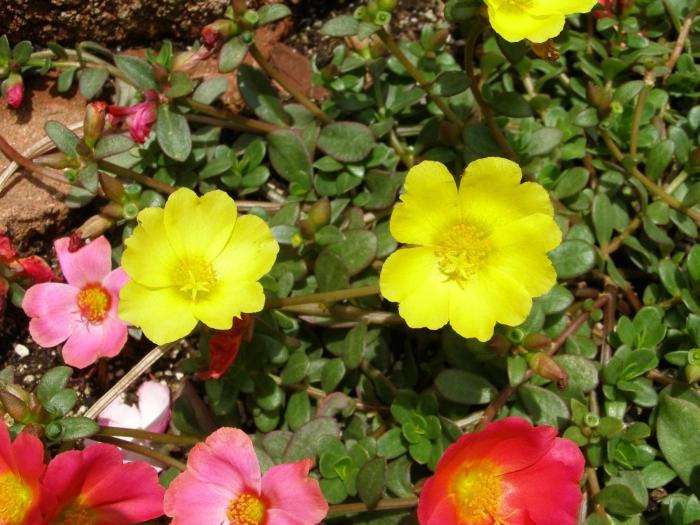

[collapse]
Propagation of campanula by cuttings
For reproduction at the end of summer, it is recommended to cut off a strong, well-ripened stalk of Campanula, put it for 7 hours in a very weak solution of potassium permanganate, then rearrange it in clean water, where it will take root, and then plant it in the ground. From above, to create a greenhouse effect, you need to cover it with a clean glass jar, which will need to be removed in the morning and evening, first for 10 minutes, and then, as the cutting takes root, the time spent in the fresh air should be increased. When the plant is fully accepted, it will no longer need such a greenhouse.
Transfer
The transplant is planned for early spring. It is important to be in time before the time the flower grows. They act depending on the age of the plant:
- The adult specimen is completely removed from the old pot. Shake off the soil from the roots, cut off dry and wilted branches, transfer to a new container. Fill with new soil, watered.
- They do differently with a young plant. They take a new pot, insert an old one with a plant into it, fill the empty space between the walls with soil. Then the flower is transferred from the old container, lowered into the formed depression and the soil is poured.
Experiencing the peaks of popularity, the plant, touchingly referred to as the bride and groom, periodically appears on our windowsills. With proper care, you can decorate your home garden with a lush blooming pet.
Complete flower care and fertilizers used
Adult milkweed bush
If you are going to grow Euphorbia in your summer cottage, then you should pay special attention to the type of soil. This flower grows well in sandy, dry ground. Does not tolerate prolonged rain and excessive watering. Also will not grow in clay soil.
To fertilize the soil, you can use fertilizing organic and mineral species.
The only thing that the plant does not tolerate is the excessive nitrogen content in the soil.
The flower feels great and grows in areas open to sunlight. Euphorbia, under the influence of full care, grows well and can bend under its own weight. To avoid this, it is necessary to tie up the plant.
If you try to grow a plant in the shade, then it will be small. The leaves will not have a rich white border, the whole plant will quickly die, and you will not enjoy its full beauty.
Expert opinion
Yulia Yurievna
I have a large garden and vegetable garden, several greenhouses. I love modern methods of plant cultivation and soil mulching, I share my experience.
Ask a Question
Although this plant is rarely affected by diseases, if the watering regime is not followed, a fungal infection can develop. Typical signs: yellowing and falling foliage. For treatment, you need to establish a watering regime, for a start, let the soil dry well. To speed up this process and slow down the development of the fungus, you can scatter a layer of ash 1-1.5 centimeters under the bush. Further, watering with a solution of manganese or boric acid is used. In the case when the condition is rapidly deteriorating, fungicides are used. Copper preparations help well. For example, you can apply Abiga-Peak. It is a universal preparation for fighting harmful fungi and bacteria. Of the pests described by the plant, it is affected by spider mites, nematodes and slugs. When infected with ticks, the aerial part of the bush is covered with a thin cobweb, the foliage dries up and falls off, as the pests draw out vital juices from it. On detailed examination, yellow and red mite bodies are noticeable.Reproduction takes place in dry air conditions. And given that the spurge does not like abundant watering, then you need to carefully monitor and carry out preventive treatments. A gentle treatment is the treatment with a solution of soap and ash. In the case of intensive reproduction, you need to use the drug Actellik or Neoron. Spraying is carried out several times. The use of personal protective equipment is mandatory. Nematodes are parasitic worms. They cause significant damage to plants, slowing down growth, deforming aerial parts, reducing flowering and reducing overall immunity. Young plants often die. In addition to what is described, these parasites carry many viral infections. It is difficult to treat plants, often the required procedures lead to the death of the bushes. Better to take preventive measures. It is recommended to pour boiling water over the soil before planting. After the procedure, the soil is covered with plastic wrap to slow down the cooling. It is important that the hot water penetrates deeper, at least 25-30 centimeters. To protect garden crops, you can plant calendula or marigolds nearby. They repel pests. In case of serious damage, nematicides are used. With an abundance of slugs, ash is scattered in the area under the plants, and pests are removed mechanically.
Flower energy
Indoor bells symbolize love and happiness, two-tone color is identified with masculine and feminine principles. To bring joy and good luck, you need to give just a pair of white and blue colors.
It is believed that campanula is capable of transforming negative energy - absorbing all negative emotions, and in return saturating the space with optimism and happiness. There is a sign that if the bell suddenly dried up, it took a hit and saved a family member. As a thank you, you need to bury the dead flower in the ground on the street.
Temperature
In spring and summer, the most optimal temperature is 23 - 26 ° C, in winter it is better to keep plants at a low temperature from plus 12 to plus 14 ° C. In winter, do not leave the plant on the windowsill, under which the heating radiator is located, it is better to transfer it to a cool place, but keep in mind that the lower limit is + 12 ° C. Do not be afraid of temperature changes, as these plants tolerate them quite well.
Campanula has the ability to adapt to different temperatures, and thanks to this property, a flowering plant can be transferred from a room to a balcony, back and forth, without fear of any negative consequences.
Lighting
This plant is not demanding on lighting. It is not recommended to grow on the south and north windows. When grown on windowsills that face south, it is recommended to protect the plants from bright sunlight, creating shading.
If you grow campanula on the north window, then there is a risk of stretching the shoots. In such plants, the distance between the leaves increases, the decorative appearance of the plant suffers from this. Plants like a lot of light, but are afraid of direct, scalding sunlight, especially on hot summer days. Give them partial shading.
Check the roots
If outwardly the root system looks pretty good, do not rush to transplant the beauty. First, she needs to be acclimatized in your apartment or house. This is a stressful situation, and if you add a transplant to it with the release of the roots from the soil, it will not be difficult to ruin the flower.
Dilute Fitosporin in water. The concentrate should resemble strong black tea in color. Prepare an irrigation solution from this concentrate: 15 drops per liter of irrigation water. Spill "Fitosporin" over the plant. This should be done as soon as you arrived home and looked at the roots. "Fitosporin" will destroy fungi and spores that promote the spread of root and other rot.
Resting state
In late summer - early autumn, campanula stops growing, it goes into a state of dormancy. At this time, you need to cut off the elongated shoots, put the pot in a cool place, and limit watering.
With the onset of spring days, the flower comes to life, wakes up, it starts up new shoots, and it is transferred to a warm place.
back to menu ↑
See also: Beauty and Scent: Growing Lavender from Seeds at Home. Description, varieties, planting and care, stratification (50+ Photos & Videos) + Reviews
Care features
- Lighting... Campanula does not tolerate bright colors. "Shooting Star" will be much more comfortable on shaded windows. But a continuous shadow is not to the liking of the plant. From this, shoots stretch out at the campanula, and flowering becomes scarce.
- Temperature... A green pet prefers cool air, although it is afraid of drafts. It is worth overdoing it with the temperature, and the campanula will die. The optimal conditions for keeping in winter are 5-10ᵒC, in summer - up to 22ᵒC. May grow poorly due to heat. If the campanula does not bloom, then the reason often lies in the elevated temperature and the absence of a pronounced rest period.
- Watering... The plant has a negative attitude towards drying out. Watering is carried out regularly, but waterlogging should not be allowed. For this purpose, drainage from expanded clay, granular sand or crushed brick is laid in the pot. Stagnant water can be eliminated.
- Air humidity... Indoor fountains and humidifiers-ionizers will help to increase the air humidity. In the heating season, it is useful to put a container of water on the window next to the flower. It will evaporate, saturating the air with moisture.
- Top dressing... During the active growing season, the bell is fertilized. Complex fertilizers for flowering plants are suitable for feeding. The frequency of feeding is once every 2-3 weeks. It is not recommended to abuse complex fertilizers on an inorganic basis. In case of an overdose, a burn occurs and the plant dies. For active flowering, home fertilizers are used: crushed eggshells, wood ash, yeast diluted in water.
- Pruning... In March, the plant should be heavily pruned. This will improve subsequent flowering and give the bell a neat appearance. A shooting star should be trimmed when pulling shoots, drying leaves, and also if greens are actively developing instead of flowers.
Care rules
Campanula is a gentle, but not whimsical flower that does not require complex care at home.
Site selection and lighting
Campanula has a love for the bright, but diffused light... She will love to live in the east or west window. If you place the campanula on the south window, you will need to provide it with shading from the direct rays of the sun.
Campanula on the north window, most likely, will suffer from a lack of light, which will lead to stretching of the shoots and an increase in the gaps between the leaves, and this will worsen the appearance of the plant.
In the summer, Campanula thrives at temperatures from 20 to 22 ° C, and in the winter - from 12 to 14 ° C. Cool wintering provides the plant with the best conditions to prepare for flowering.
Watering and humidity
In spring and summer, when Campanula actively grows and blooms, it requires abundant watering and constant soil moisture. However, in watering need to know when to stopto prevent water from stagnating in the pot or sump.
In the fall, watering the campanula should be gradually reduced so that the plant can prepare for rest.
In winter, when it is desirable to keep the campanula cool, it should be watered very rarely (once or twice a month).
Campanula is not at all whimsical to air humidity. However, in the hot season and when living next to the battery in winter, it does not hurt regularly spray a plant.
Flowering and dormant period
Campanula flowers can be white, purple or blue. In order for flowering to be abundant and long-lasting, it is necessary to promptly remove wilted "bells".
In summer, keeping campanula outdoors in partial shade is a good solution. Interestingly, when the plant is placed on the south window in winter, it can bloom.
In autumn, when daylight hours are increasingly shrinking, campanula stops growing and goes into resting state... In order to best prepare it for rest, it is recommended to cut off the elongated branches and keep the plant cool.
In the spring, it is necessary to return the plant to a warm room, remove dried shoots, and also gradually increase watering.
For tips from florists for caring for Nolina at home, read our article.
Learn how to care for indoor balsam from our material.
Transplant and feeding
Campanula loves to grow in loose soil, allowing her roots breathe freely... For planting, you can use ready-made soil for flowering plants, or make the following mixture:
- 1 piece of leafy land;
- 1 part of peat land;
- 1 part of humus earth;
- 1 part coarse sand.
Transplant campanula follows every spring. However, the plant does not have a very long lifespan, so new cuttings can be planted every year. On average, a campanula lives indoors for a year or two, and then you need to update it.
Campanula is excellent for growing as ampel plant in hanging containers and pots. For a strong root system, Campanula requires a wide, not deep pot.
In spring and summer you can feed campanula fertilizer for flowering plants every two weeks.
The uniqueness of the name of the flower
This plant grows rapidly. The bush becomes lush in a matter of days. Looks gorgeous on the flower bed. Because of this, in the common people he is also called "The Rich Bride". This flower is self-seeding in the flower bed every year. It grows in large areas, from which it received another nickname - "The Eternal Bride".
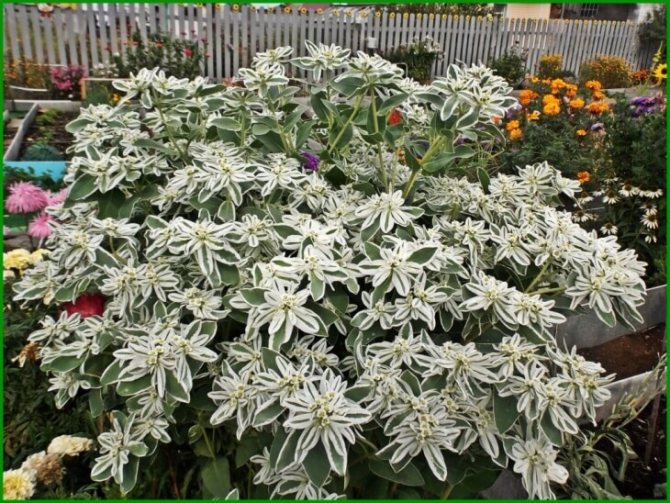

Lat. Euphorbia
Euphorbia has small flowers that are located at the very top of the shoots. Because of the white border on the leaves, at first glance it seems that the whole bush is in bloom. This flower has extraordinary beauty, is able to transform. From the beginning of growth, the leaves are green, then turn white at the edges, as if reincarnating for a solemn moment.
From the outside, it seems that the milkweed bushes are sprinkled with fresh fallen snow. The seeds of this flower can be found in any plant store in your city called "Summer Snow" precisely because of this similarity.
This flower has varieties. Some flowers bloom and delight with their beauty, having rounded leaves. In another variety, they are more pointed.
On average, with proper care, plant height reaches 90 centimeters. The leaves are no more than seven centimeters long. The stems are well branched. When the maximum growth is reached and in particularly windy weather, the plant must be tied to pegs or a fence. The color scheme of Milkweed does not deteriorate from rain and does not fade from sunlight. In any weather, this flower will delight your eye with its beautiful appearance.
Main types
Campanula is the most popular among florists, a detailed description of this species was given at the beginning of the article. Even at home, the following species are cultivated:
Campanula Blauranca


This plant is a stunted variety of Pozharsky's campanula. The foliage of this plant is large, and the color of the flowers is bluish. In length, the stems can reach about 20 centimeters. This flower can be grown both in the garden and at home.
Terry campanula


This hybrid was created by crossing the spoon-leaved Campanula and the Carpathian. The plant is small and at the same time many double flowers of blue, white and purple bloom on it. The flexible stems of this flower are almost impossible to see due to the many carved leaf plates. This plant is very effective, but it is demanding in terms of keeping conditions.
Campanula Carpathian, or Carpathian bell
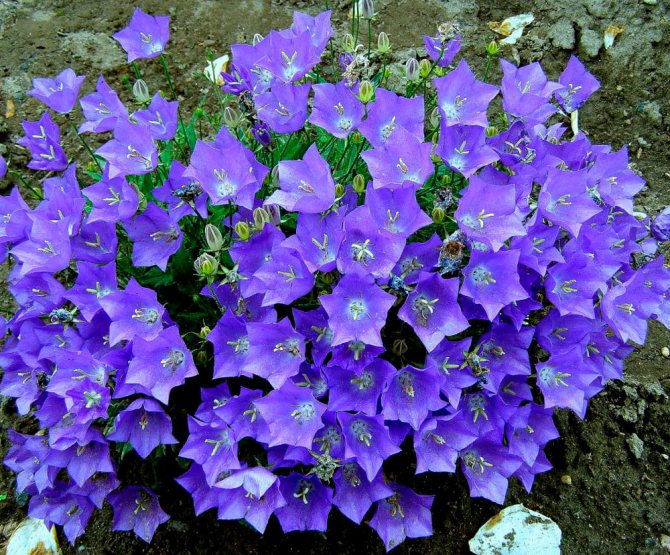

This annual plant has ovoid-rounded foliage, it is placed in the root part like a rosette. In diameter, the flowers reach about 50 mm, they can be colored blue, white or purple. The most popular of all garden forms are such as: Alba and White Star - with white flowers; Riversley, Blaumeise and Chenton John - blue flowers; Carpatenkrone - purple flowers; Celestine and Isabelle - flowers have a sky-blue tint.
Introduction
How did I first meet the beautiful Bride and Groom flower? Growing indoor plants is my passion. They decorate the house with unusually bright flowers and variegated leaves. Watching how green pets develop is very interesting. In the spring, a friend gave me a small stalk of a plant, and said that it was called "bride and groom."
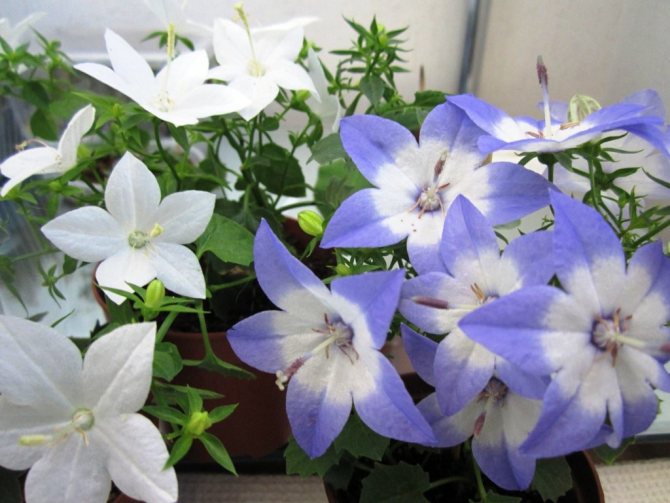

Among the people, the flower called campanula was given the romantic name "bride and groom"
I put it in water and a few weeks later, when the roots appeared, I planted it in a pot. Used a soil mixture of greenhouse and leaf soil, peat and sand. The stalk took root easily, went into growth.
I put the container with the plant in a deep tray and every morning I poured settled water into it so that the plant did not experience a lack of moisture. Once every two weeks, I watered it with special fertilizers for flowering indoor plants.
I pinched the side shoots that quickly grew, and soon the bush became very branched and lush, numerous buds appeared on it, which bloomed one after another.
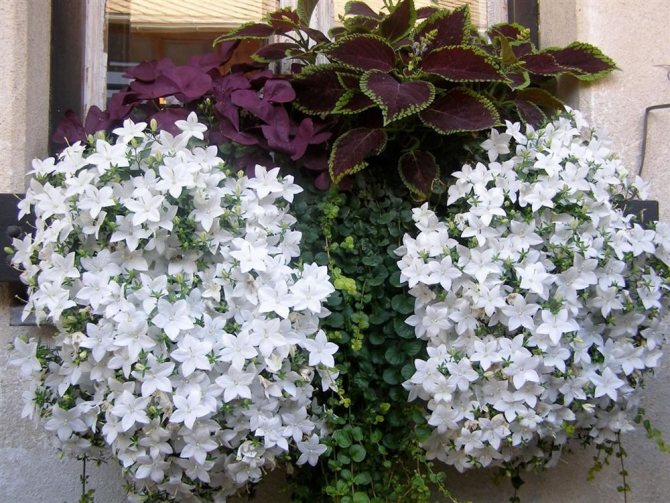

Composition of Campanula and Coleus
And somehow the plant was covered with the most delicate flowers. The bride and groom plant looked great on the window. For the summer, I put him on the balcony, where she felt especially good.
After a long flowering at the end of summer, the campanula threw off the foliage, the shoots stretched out, I carefully cut them off and put the container in a cool place. With the onset of spring, she began to water the plants again, put it on the windowsill. Soon new shoots appeared and already in mid-May, the "bride and groom" pleased with their flowering again.
back to menu ↑
See also: Saxifrage: description, types and varieties, reproduction, growing from seeds, planting in open ground, care (110+ Photos & Videos) + Reviews
Reproduction
Campanula is able to reproduce:
- Cuttings. This is the simplest method and it is important to only use cuttings from the bottom of the shoots. The rooting process in a peat-sand mixture is not difficult. Until complete rooting, you should not water the cuttings, it is better to just spray them. When the cuttings grow up to 10 cm in height, you need to pinch them in order to provoke the growth of side shoots. Cuttings planted in summer will rest in autumn and winter, and in January or February they can already bloom.
- Seeds. Very small seeds of campanula must be planted in containers with soil, evenly distributing them over the surface and lightly sprinkling on top with the same soil. The seedlings do not need watering; spraying is more suitable.
- By dividing the bush. In the spring, you can remove the overgrown plant from the pot and divide it with a sharp knife into two or three parts. It is important not to shake off the ground so as not to damage the roots. When planting a campanula, you do not need to deeply deepen it.
Keeping and growing campanula
Basic care mistakes
- Do not plant seeds after long-term storage. Only fresh.
- Do not soak. It is enough to etch in Apirin solution for 15 minutes.
- Avoid stagnation of moisture in the soil. Neutral soil should be moisture permeable.
Creation of favorable conditions
Adaptation. An unpretentious flower does not need special care.
After adaptation in a new place, after a few days, it can be transplanted into another container.
Drainage. The root system needs a wide planter with drainage at the bottom and a fresh mixture of humus, peat, coarse sand and leafy soil.
Lighting. So that the shoots do not stretch out with a lack of light and do not worsen the decorative effect, the bush must be provided with good diffused lighting.
Heat. Campanula feels well at an air temperature of +20 to +22 degrees. She loves fresh air, but cannot stand the heat.
Water the plant in summer, it is necessary abundantly and regularly, avoiding stagnant moisture. Daily spraying is helpful.
For feeding recommended solution "Kemira Suite»Or other complex fertilizers that can be bought in specialized stores.
Preparing for winter
In autumn, calm comes, flowering stops, and the following preparation is needed here:
- cut off all extended shoots to ten centimeters;
- transfer the flower to a lighted place with a low temperature;
- watering - 1-2 times a month.
With the onset of spring, campanula is transferred to a warm room, dried shoots are removed, watered more often and, if necessary, begin a transplant.
Reproduction of indoor flower bride
Campanula can multiply:
- division;
- cuttings;
- seeds.
The easiest way to reproduce a Bride and Groom is dividing a bush... The procedure is recommended in early spring. To do this, you need to remove Campanula completely from the container and carefully divide the plant into several parts, without shaking off the ground from the roots. If the earth has stuck together into one large ball, it can be cut with a knife. You should not divide the plant into too small parts.
Cuttings can also be attributed to the popular breeding method of Campanula. This procedure is also performed in the spring. For this purpose, you need to carefully tear off young shoots that have reached 10-20 centimeters in length. The torn pieces can either be placed in a container of water or planted in a pot filled with a mixture of earth and peat. In the second case, planting should be placed in a cool room with an air temperature within 12 degrees Celsius and watered with an aqueous solution of phytosporin. After the cuttings grow, you should carefully pinch the top to stimulate the growth of lateral shoots. Indoor flower Bride, the care of which does not bring much trouble, gratefully gives the owners its tenderness and beauty. It is believed that this beautiful flower brings family happiness to newlyweds, therefore it is often presented to newlyweds.
Indoor bride flower. Care
In some traditions, it is believed that for happiness and love in a young family, it will be enough to give the newlyweds a delicate flower for the wedding with a romantic name - "bride and groom".
Its white and blue bell-shaped flowers are also called campanula (Greek - bell).
This plant grows wild in many parts of southern Europe.
The cultivated species of Campanula isophylla Moretti are used by flower growers all over the world.
Purchase of a plant
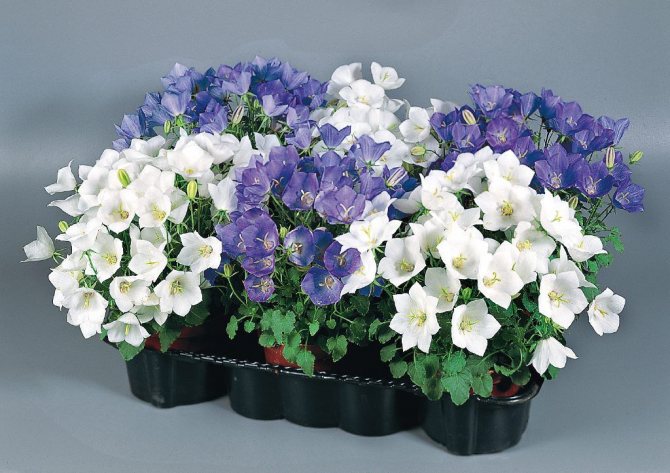

Before proceeding with the implementation of our recommendations, you must purchase the plant itself. You can buy it in stores, having studied the flower departments. I must say that he is not a very frequent visitor to such places. But if you are lucky, then you will become the proud owner (or possessor) of this green pet.
The second purchase option is to buy from grandmothers. Ask around, maybe someone will agree to sell you a young plant.
Flower varieties
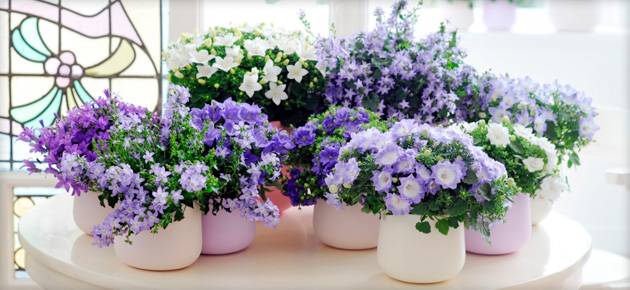

Feel good at home:
- Mayi) Is a common variety that is close to its progenitor - the wild bell. Has pubescent leaves and rich colors;
- Napoli - grows faster, blooms brighter, has blue flowers with a purple tint;
- Atlanta White (Atlanta White) - a plant with white inflorescences, also known as Alba;
- Dublin Blue and Dublin White (Dublin Blue, Dublin White) - blue and white double bell with long flowering time;
- Berlin Bicolor - an original flower that pleases with white and blue flowers;
- Dublin Bicolor - a variety similar to the previous one is rarely found on sale.
All varieties are characterized by stockiness, ease of cultivation, and abundant flowering. Allergy to a blooming bell is a rare phenomenon, so the plant is willingly grown at home.
Some varieties with drooping shoots reach a length of 40 cm. None of the indoor varieties are poisonous, but cats are not allowed to the plant. And it's not about the danger for pets, but about the fact that a cat may like the bell, and she will eat it to the core.
Campanula care requirements
Despite the fact that the plant looks fragile, it is very easy to care for an indoor flower. It is necessary to choose the right soil, watering regime and lighting. Immediately after purchase, the plant should be kept at rest and transplanted only after a few days. It is better to choose a pot that is low and wide, since the root system develops mainly in width. The substrate is made from the following components in equal proportions:
- peat:
- sand:
- leafy land;
- humus.
At the exit, the soil mixture should be loose and pass water and oxygen well. A layer of pebble or vermiculite drainage should be placed on the bottom.
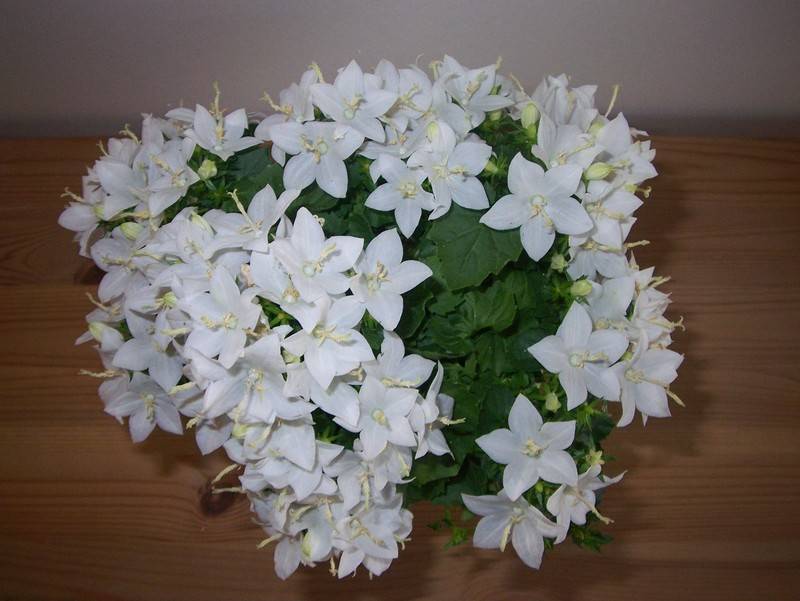

The plant prefers bright, diffused light. It is better to place the flowerpot on the eastern and northeastern windows; it is advisable to avoid direct rays during the solstice.
The optimum air temperature is 20-24 degrees Celsius, and in the summer it is allowed to move the campanula to a terrace or balcony. It is necessary to take care of the “Bride and Groom” flowers so that there is an influx of fresh air without drafts. During the dormant period, it is important to provide 12-14 degrees indoors - the bell needs a good rest before re-flowering.
The water should be at room temperature, well-separated or filtered. An admixture of lime is allowed, since in its natural environment the flower lives on calcareous soils. The regularity of watering depends on the ambient temperature. In the summer heat, it is required to provide the plant with regular moisture, the earthen lump should not dry out.
In winter, the frequency of watering is reduced to about 1 time per month. Stagnation of liquid in the pan should not be allowed - the roots will begin to rot, and the home beauty may die. Additional spraying is required year-round, especially if in cold weather the pot is located near the heaters.
In the spring, after waking up, it is required to provide regular feeding. Fertilizers should be chosen for flowering indoor plants. It is recommended to add nutrients every 10 days.
The soil
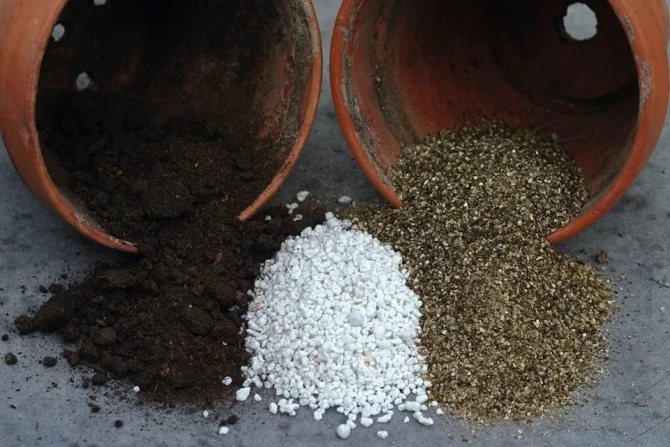

Preparation of soil mixture
Campanula loves loose, oxygen-rich soil. It is important that the roots breathe well, so that the soil is not compressed. A mixture of humus, rotten foliage, peat and sand in equal volumes is well suited.
back to menu ↑
See also: Homemade rose in a pot: how to care for it after buying it at home? (20+ Photos & Videos) + Reviews


